Management of Traditional Projects - Individual Narrated Power Point Presentation
VerifiedAdded on 2023/01/20
|26
|2932
|97
AI Summary
This document is an individual narrated PowerPoint presentation on the management of traditional projects. It includes an introduction to project management, a project brief for the Guyana Geology and Mines Commission (GGMC), and an outline of the project's objectives, scope, constraints, and desired outcomes. The document also provides information on the project management team and role descriptions.
Contribute Materials
Your contribution can guide someone’s learning journey. Share your
documents today.
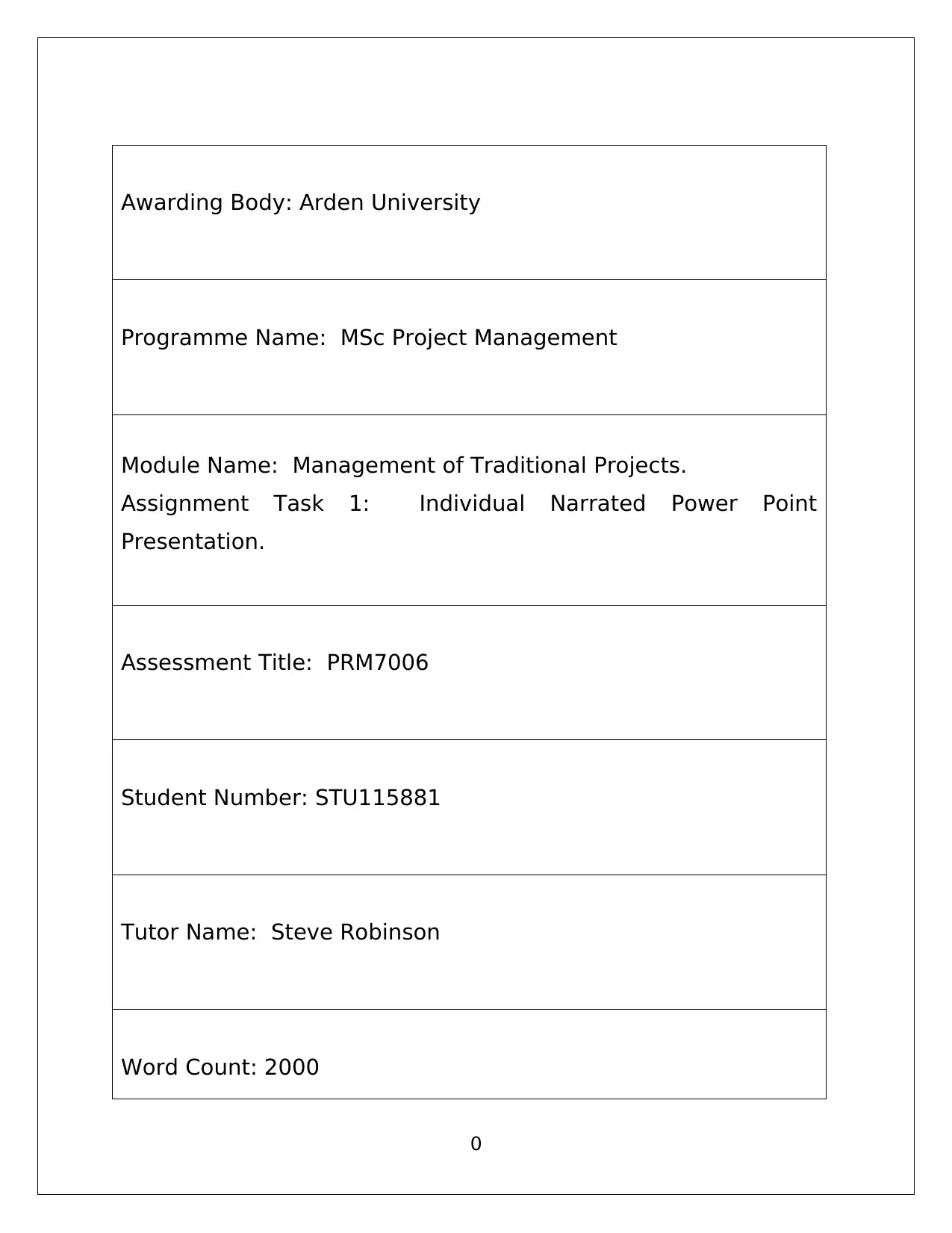
Awarding Body: Arden University
Programme Name: MSc Project Management
Module Name: Management of Traditional Projects.
Assignment Task 1: Individual Narrated Power Point
Presentation.
Assessment Title: PRM7006
Student Number: STU115881
Tutor Name: Steve Robinson
Word Count: 2000
0
Programme Name: MSc Project Management
Module Name: Management of Traditional Projects.
Assignment Task 1: Individual Narrated Power Point
Presentation.
Assessment Title: PRM7006
Student Number: STU115881
Tutor Name: Steve Robinson
Word Count: 2000
0
Secure Best Marks with AI Grader
Need help grading? Try our AI Grader for instant feedback on your assignments.
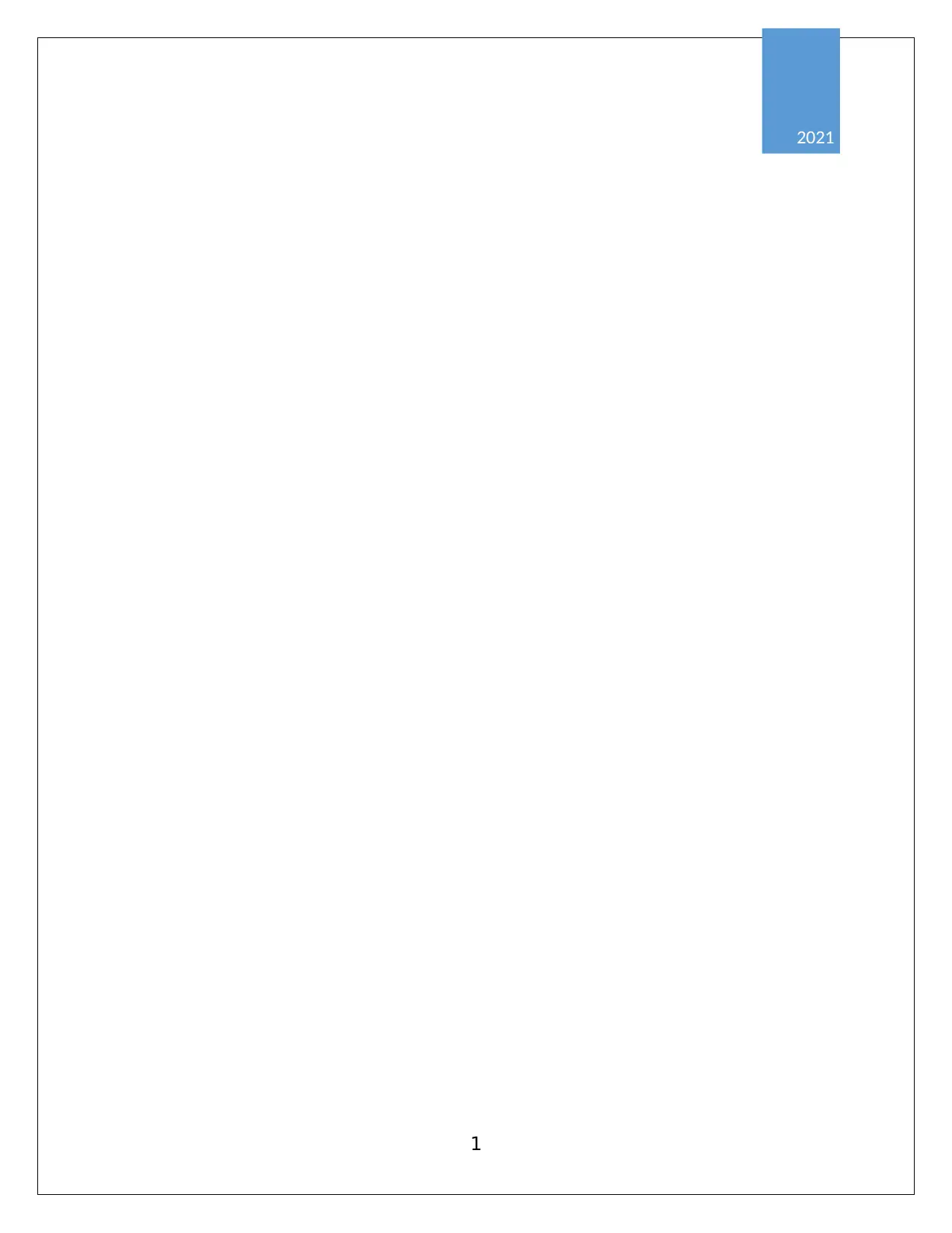
1
2021
2021
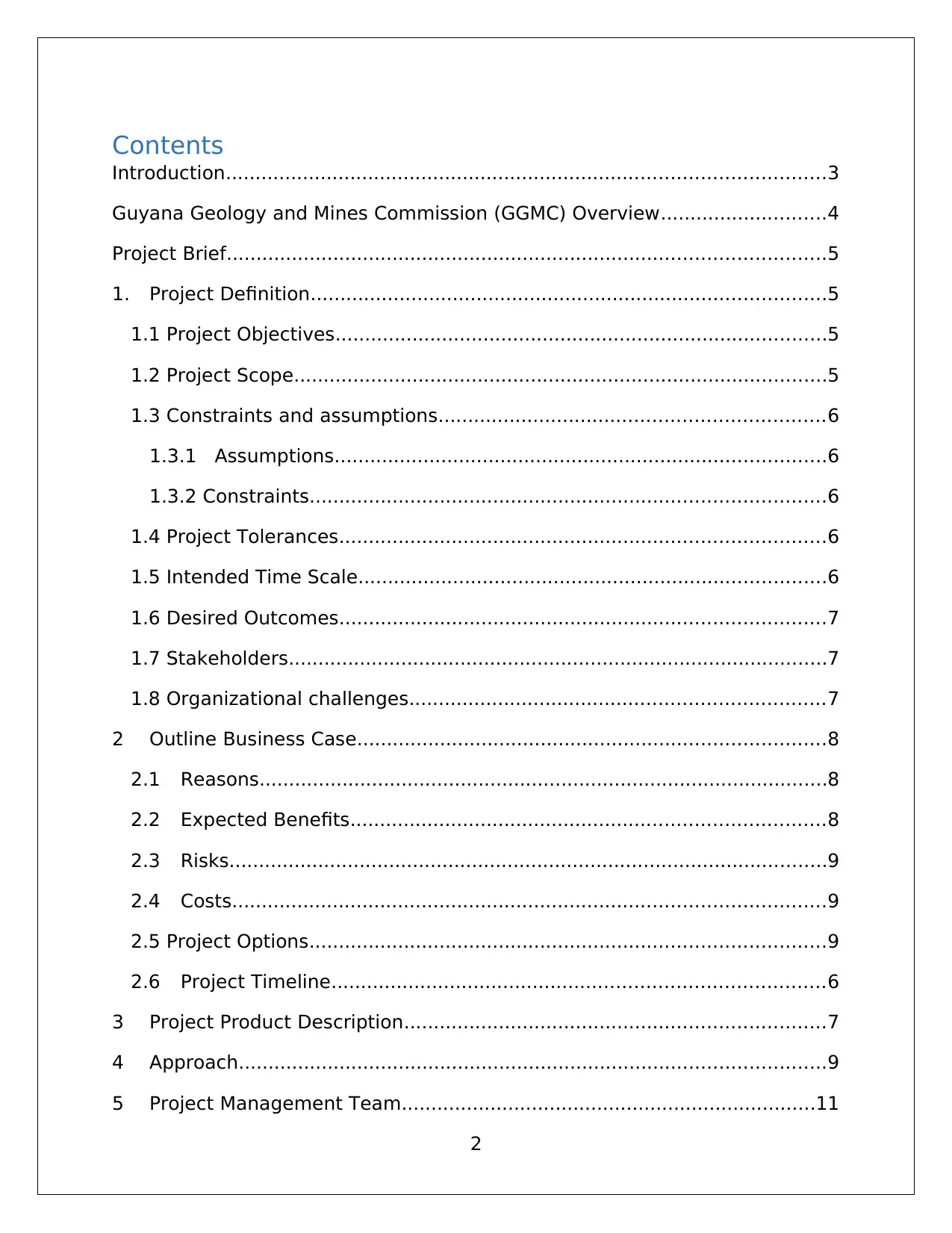
Contents
Introduction.....................................................................................................3
Guyana Geology and Mines Commission (GGMC) Overview............................4
Project Brief.....................................................................................................5
1. Project Definition.......................................................................................5
1.1 Project Objectives...................................................................................5
1.2 Project Scope..........................................................................................5
1.3 Constraints and assumptions.................................................................6
1.3.1 Assumptions...................................................................................6
1.3.2 Constraints.......................................................................................6
1.4 Project Tolerances..................................................................................6
1.5 Intended Time Scale...............................................................................6
1.6 Desired Outcomes..................................................................................7
1.7 Stakeholders...........................................................................................7
1.8 Organizational challenges......................................................................7
2 Outline Business Case...............................................................................8
2.1 Reasons................................................................................................8
2.2 Expected Benefits................................................................................8
2.3 Risks.....................................................................................................9
2.4 Costs....................................................................................................9
2.5 Project Options.......................................................................................9
2.6 Project Timeline...................................................................................6
3 Project Product Description.......................................................................7
4 Approach...................................................................................................9
5 Project Management Team......................................................................11
2
Introduction.....................................................................................................3
Guyana Geology and Mines Commission (GGMC) Overview............................4
Project Brief.....................................................................................................5
1. Project Definition.......................................................................................5
1.1 Project Objectives...................................................................................5
1.2 Project Scope..........................................................................................5
1.3 Constraints and assumptions.................................................................6
1.3.1 Assumptions...................................................................................6
1.3.2 Constraints.......................................................................................6
1.4 Project Tolerances..................................................................................6
1.5 Intended Time Scale...............................................................................6
1.6 Desired Outcomes..................................................................................7
1.7 Stakeholders...........................................................................................7
1.8 Organizational challenges......................................................................7
2 Outline Business Case...............................................................................8
2.1 Reasons................................................................................................8
2.2 Expected Benefits................................................................................8
2.3 Risks.....................................................................................................9
2.4 Costs....................................................................................................9
2.5 Project Options.......................................................................................9
2.6 Project Timeline...................................................................................6
3 Project Product Description.......................................................................7
4 Approach...................................................................................................9
5 Project Management Team......................................................................11
2

6 Role Descriptions.....................................................................................13
Conclusion.....................................................................................................15
References.....................................................................................................16
3
Conclusion.....................................................................................................15
References.....................................................................................................16
3
Secure Best Marks with AI Grader
Need help grading? Try our AI Grader for instant feedback on your assignments.

Introduction
Project Management (PM) has been a part of every functional organization
and is the most widely used model in the management of an organization
(Huemann, et al, 2017).. As Project Management developed into a more
functional approach, the usage of a systematic approach in undertaking a
project was adapted.
The purpose of this narrative is to provide readers with the steps undertaken
for the development of a project, Mineral Property Management System,
within the Guyana Geology and Mines Commission (GGMC). The necessary
project-related information that will ultimately increase customers for the
organization and convince Management to invest in making the project a
reality will be provided. The layout of the narrative entails a summary of the
organization under study followed by a description of the elements within a
project brief.
4
Project Management (PM) has been a part of every functional organization
and is the most widely used model in the management of an organization
(Huemann, et al, 2017).. As Project Management developed into a more
functional approach, the usage of a systematic approach in undertaking a
project was adapted.
The purpose of this narrative is to provide readers with the steps undertaken
for the development of a project, Mineral Property Management System,
within the Guyana Geology and Mines Commission (GGMC). The necessary
project-related information that will ultimately increase customers for the
organization and convince Management to invest in making the project a
reality will be provided. The layout of the narrative entails a summary of the
organization under study followed by a description of the elements within a
project brief.
4
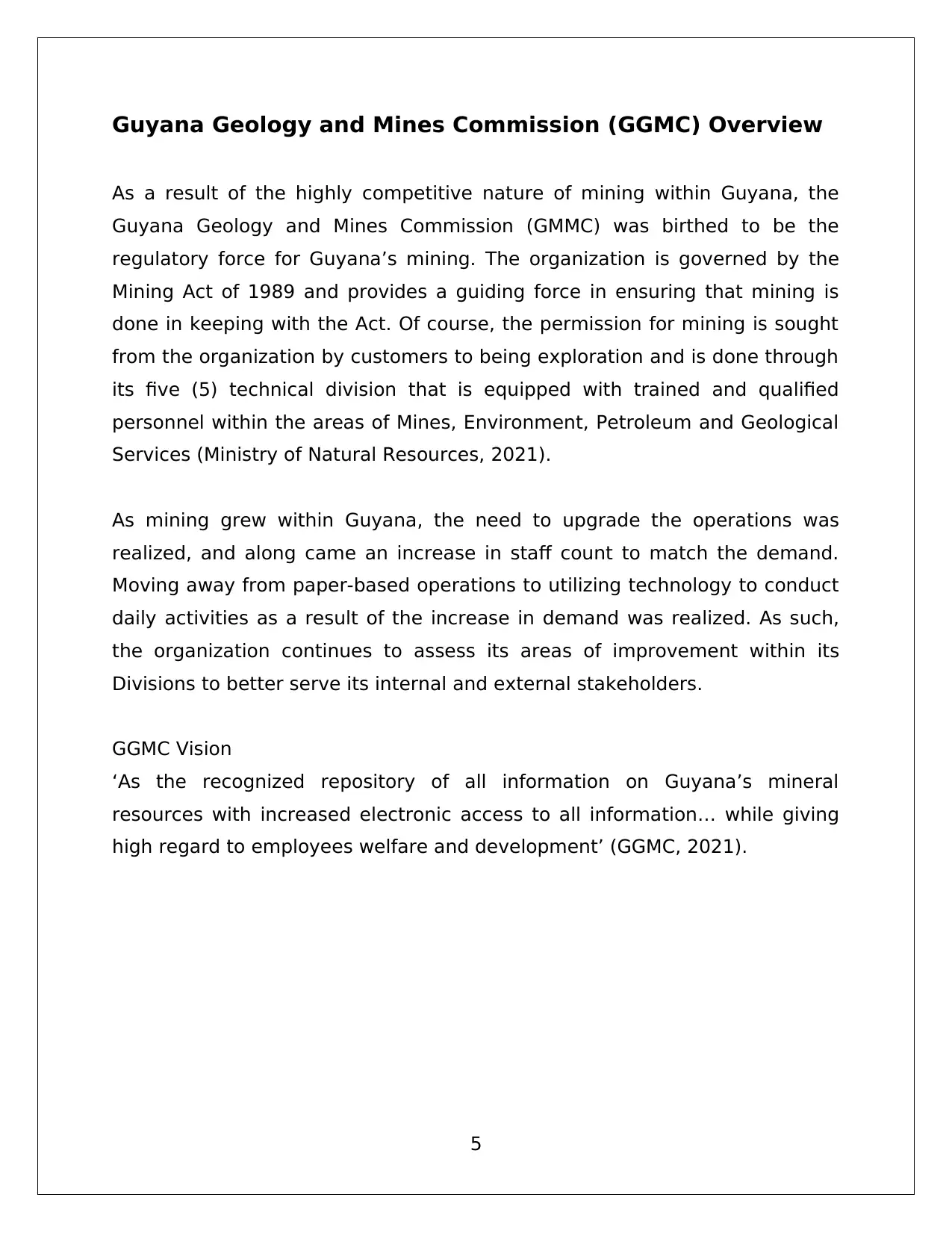
Guyana Geology and Mines Commission (GGMC) Overview
As a result of the highly competitive nature of mining within Guyana, the
Guyana Geology and Mines Commission (GMMC) was birthed to be the
regulatory force for Guyana’s mining. The organization is governed by the
Mining Act of 1989 and provides a guiding force in ensuring that mining is
done in keeping with the Act. Of course, the permission for mining is sought
from the organization by customers to being exploration and is done through
its five (5) technical division that is equipped with trained and qualified
personnel within the areas of Mines, Environment, Petroleum and Geological
Services (Ministry of Natural Resources, 2021).
As mining grew within Guyana, the need to upgrade the operations was
realized, and along came an increase in staff count to match the demand.
Moving away from paper-based operations to utilizing technology to conduct
daily activities as a result of the increase in demand was realized. As such,
the organization continues to assess its areas of improvement within its
Divisions to better serve its internal and external stakeholders.
GGMC Vision
‘As the recognized repository of all information on Guyana’s mineral
resources with increased electronic access to all information… while giving
high regard to employees welfare and development’ (GGMC, 2021).
5
As a result of the highly competitive nature of mining within Guyana, the
Guyana Geology and Mines Commission (GMMC) was birthed to be the
regulatory force for Guyana’s mining. The organization is governed by the
Mining Act of 1989 and provides a guiding force in ensuring that mining is
done in keeping with the Act. Of course, the permission for mining is sought
from the organization by customers to being exploration and is done through
its five (5) technical division that is equipped with trained and qualified
personnel within the areas of Mines, Environment, Petroleum and Geological
Services (Ministry of Natural Resources, 2021).
As mining grew within Guyana, the need to upgrade the operations was
realized, and along came an increase in staff count to match the demand.
Moving away from paper-based operations to utilizing technology to conduct
daily activities as a result of the increase in demand was realized. As such,
the organization continues to assess its areas of improvement within its
Divisions to better serve its internal and external stakeholders.
GGMC Vision
‘As the recognized repository of all information on Guyana’s mineral
resources with increased electronic access to all information… while giving
high regard to employees welfare and development’ (GGMC, 2021).
5
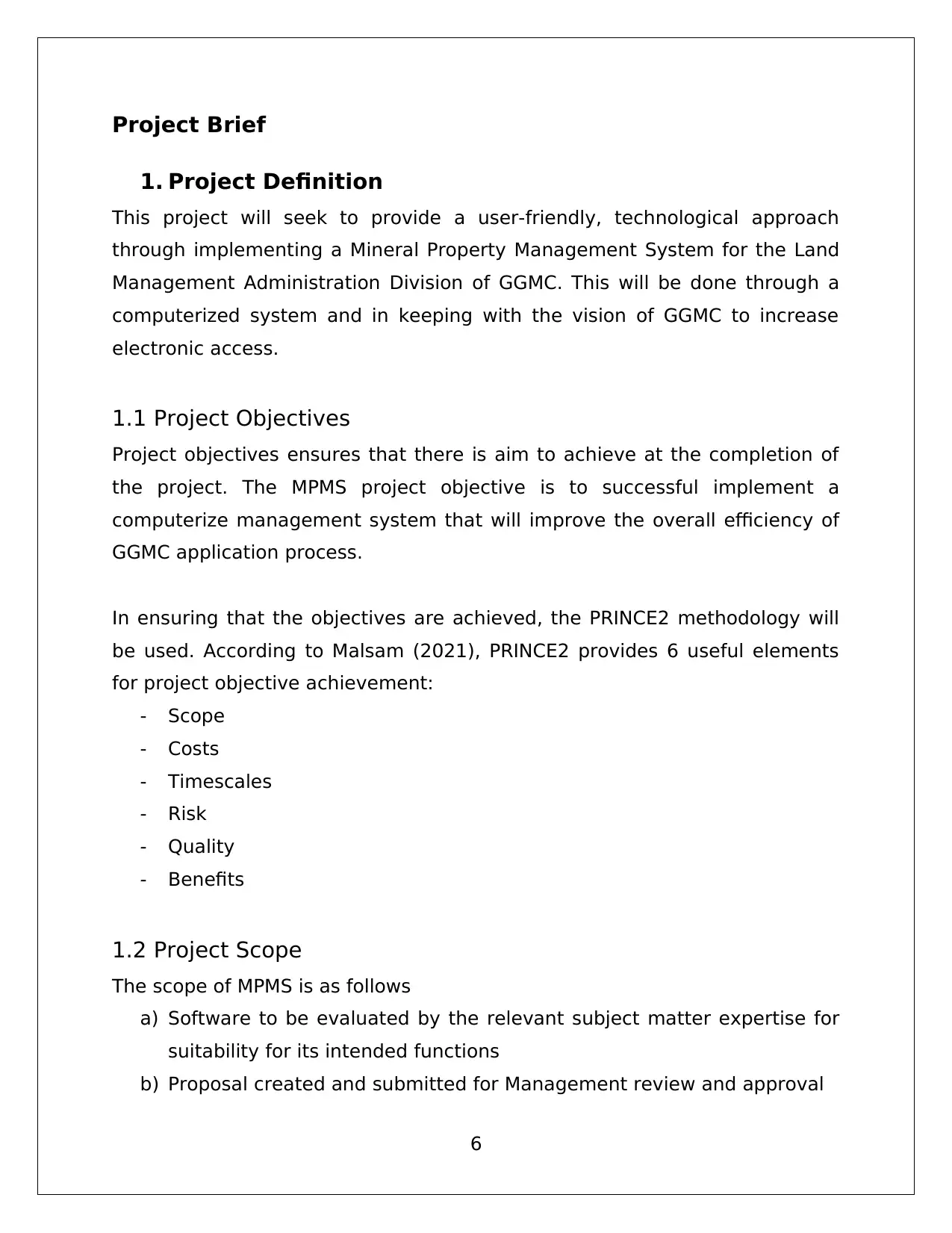
Project Brief
1. Project Definition
This project will seek to provide a user-friendly, technological approach
through implementing a Mineral Property Management System for the Land
Management Administration Division of GGMC. This will be done through a
computerized system and in keeping with the vision of GGMC to increase
electronic access.
1.1 Project Objectives
Project objectives ensures that there is aim to achieve at the completion of
the project. The MPMS project objective is to successful implement a
computerize management system that will improve the overall efficiency of
GGMC application process.
In ensuring that the objectives are achieved, the PRINCE2 methodology will
be used. According to Malsam (2021), PRINCE2 provides 6 useful elements
for project objective achievement:
- Scope
- Costs
- Timescales
- Risk
- Quality
- Benefits
1.2 Project Scope
The scope of MPMS is as follows
a) Software to be evaluated by the relevant subject matter expertise for
suitability for its intended functions
b) Proposal created and submitted for Management review and approval
6
1. Project Definition
This project will seek to provide a user-friendly, technological approach
through implementing a Mineral Property Management System for the Land
Management Administration Division of GGMC. This will be done through a
computerized system and in keeping with the vision of GGMC to increase
electronic access.
1.1 Project Objectives
Project objectives ensures that there is aim to achieve at the completion of
the project. The MPMS project objective is to successful implement a
computerize management system that will improve the overall efficiency of
GGMC application process.
In ensuring that the objectives are achieved, the PRINCE2 methodology will
be used. According to Malsam (2021), PRINCE2 provides 6 useful elements
for project objective achievement:
- Scope
- Costs
- Timescales
- Risk
- Quality
- Benefits
1.2 Project Scope
The scope of MPMS is as follows
a) Software to be evaluated by the relevant subject matter expertise for
suitability for its intended functions
b) Proposal created and submitted for Management review and approval
6
Paraphrase This Document
Need a fresh take? Get an instant paraphrase of this document with our AI Paraphraser
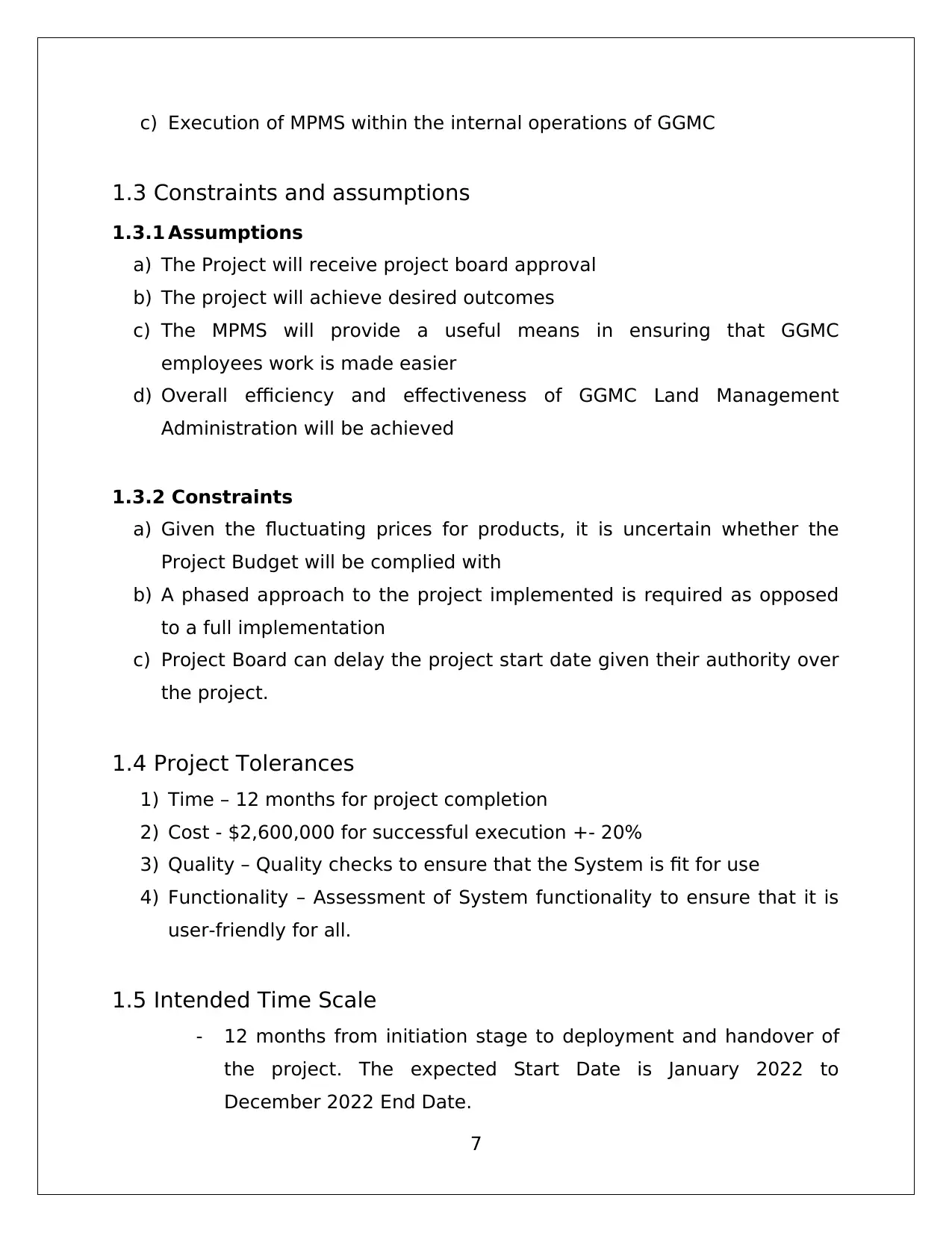
c) Execution of MPMS within the internal operations of GGMC
1.3 Constraints and assumptions
1.3.1 Assumptions
a) The Project will receive project board approval
b) The project will achieve desired outcomes
c) The MPMS will provide a useful means in ensuring that GGMC
employees work is made easier
d) Overall efficiency and effectiveness of GGMC Land Management
Administration will be achieved
1.3.2 Constraints
a) Given the fluctuating prices for products, it is uncertain whether the
Project Budget will be complied with
b) A phased approach to the project implemented is required as opposed
to a full implementation
c) Project Board can delay the project start date given their authority over
the project.
1.4 Project Tolerances
1) Time – 12 months for project completion
2) Cost - $2,600,000 for successful execution +- 20%
3) Quality – Quality checks to ensure that the System is fit for use
4) Functionality – Assessment of System functionality to ensure that it is
user-friendly for all.
1.5 Intended Time Scale
- 12 months from initiation stage to deployment and handover of
the project. The expected Start Date is January 2022 to
December 2022 End Date.
7
1.3 Constraints and assumptions
1.3.1 Assumptions
a) The Project will receive project board approval
b) The project will achieve desired outcomes
c) The MPMS will provide a useful means in ensuring that GGMC
employees work is made easier
d) Overall efficiency and effectiveness of GGMC Land Management
Administration will be achieved
1.3.2 Constraints
a) Given the fluctuating prices for products, it is uncertain whether the
Project Budget will be complied with
b) A phased approach to the project implemented is required as opposed
to a full implementation
c) Project Board can delay the project start date given their authority over
the project.
1.4 Project Tolerances
1) Time – 12 months for project completion
2) Cost - $2,600,000 for successful execution +- 20%
3) Quality – Quality checks to ensure that the System is fit for use
4) Functionality – Assessment of System functionality to ensure that it is
user-friendly for all.
1.5 Intended Time Scale
- 12 months from initiation stage to deployment and handover of
the project. The expected Start Date is January 2022 to
December 2022 End Date.
7
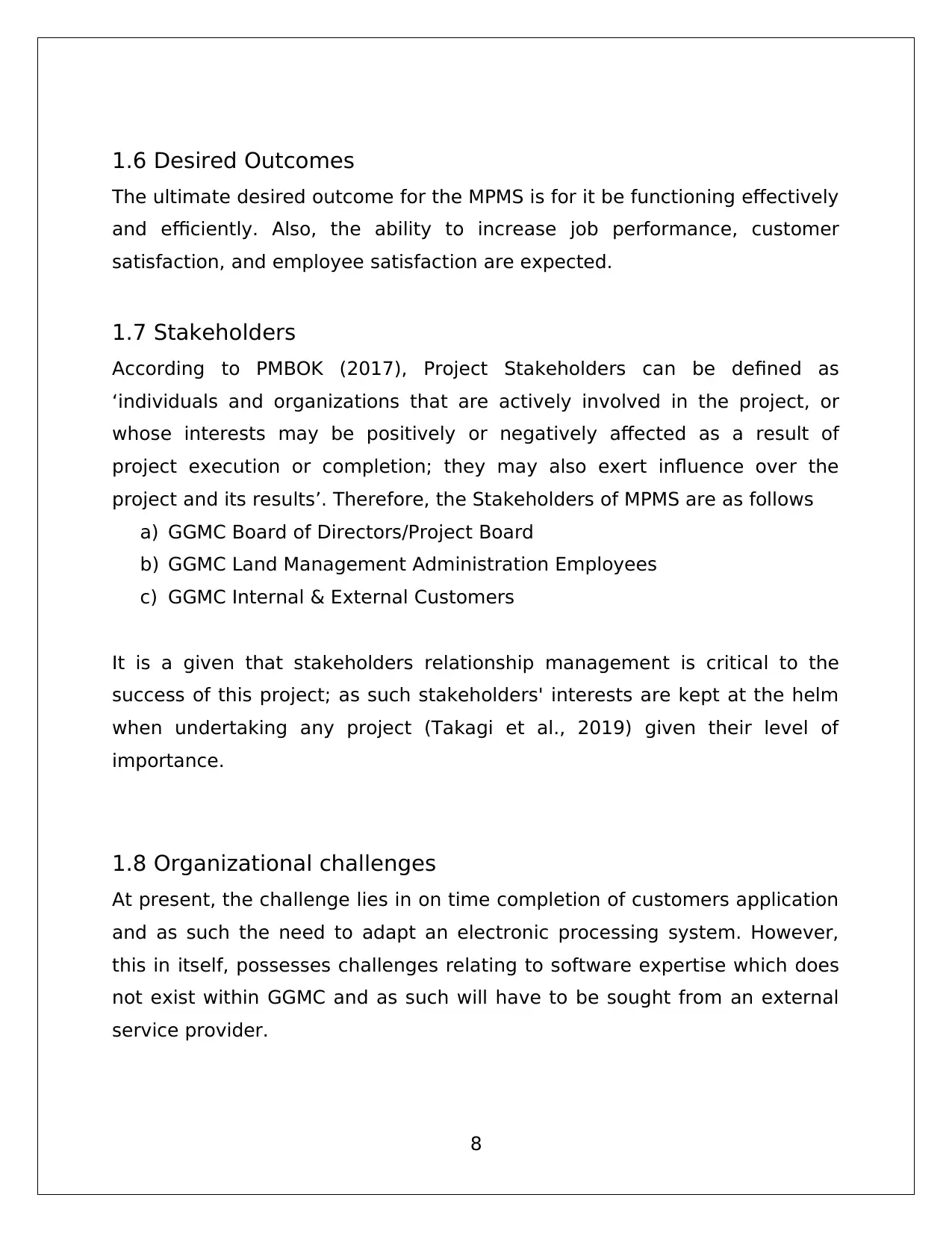
1.6 Desired Outcomes
The ultimate desired outcome for the MPMS is for it be functioning effectively
and efficiently. Also, the ability to increase job performance, customer
satisfaction, and employee satisfaction are expected.
1.7 Stakeholders
According to PMBOK (2017), Project Stakeholders can be defined as
‘individuals and organizations that are actively involved in the project, or
whose interests may be positively or negatively affected as a result of
project execution or completion; they may also exert influence over the
project and its results’. Therefore, the Stakeholders of MPMS are as follows
a) GGMC Board of Directors/Project Board
b) GGMC Land Management Administration Employees
c) GGMC Internal & External Customers
It is a given that stakeholders relationship management is critical to the
success of this project; as such stakeholders' interests are kept at the helm
when undertaking any project (Takagi et al., 2019) given their level of
importance.
1.8 Organizational challenges
At present, the challenge lies in on time completion of customers application
and as such the need to adapt an electronic processing system. However,
this in itself, possesses challenges relating to software expertise which does
not exist within GGMC and as such will have to be sought from an external
service provider.
8
The ultimate desired outcome for the MPMS is for it be functioning effectively
and efficiently. Also, the ability to increase job performance, customer
satisfaction, and employee satisfaction are expected.
1.7 Stakeholders
According to PMBOK (2017), Project Stakeholders can be defined as
‘individuals and organizations that are actively involved in the project, or
whose interests may be positively or negatively affected as a result of
project execution or completion; they may also exert influence over the
project and its results’. Therefore, the Stakeholders of MPMS are as follows
a) GGMC Board of Directors/Project Board
b) GGMC Land Management Administration Employees
c) GGMC Internal & External Customers
It is a given that stakeholders relationship management is critical to the
success of this project; as such stakeholders' interests are kept at the helm
when undertaking any project (Takagi et al., 2019) given their level of
importance.
1.8 Organizational challenges
At present, the challenge lies in on time completion of customers application
and as such the need to adapt an electronic processing system. However,
this in itself, possesses challenges relating to software expertise which does
not exist within GGMC and as such will have to be sought from an external
service provider.
8
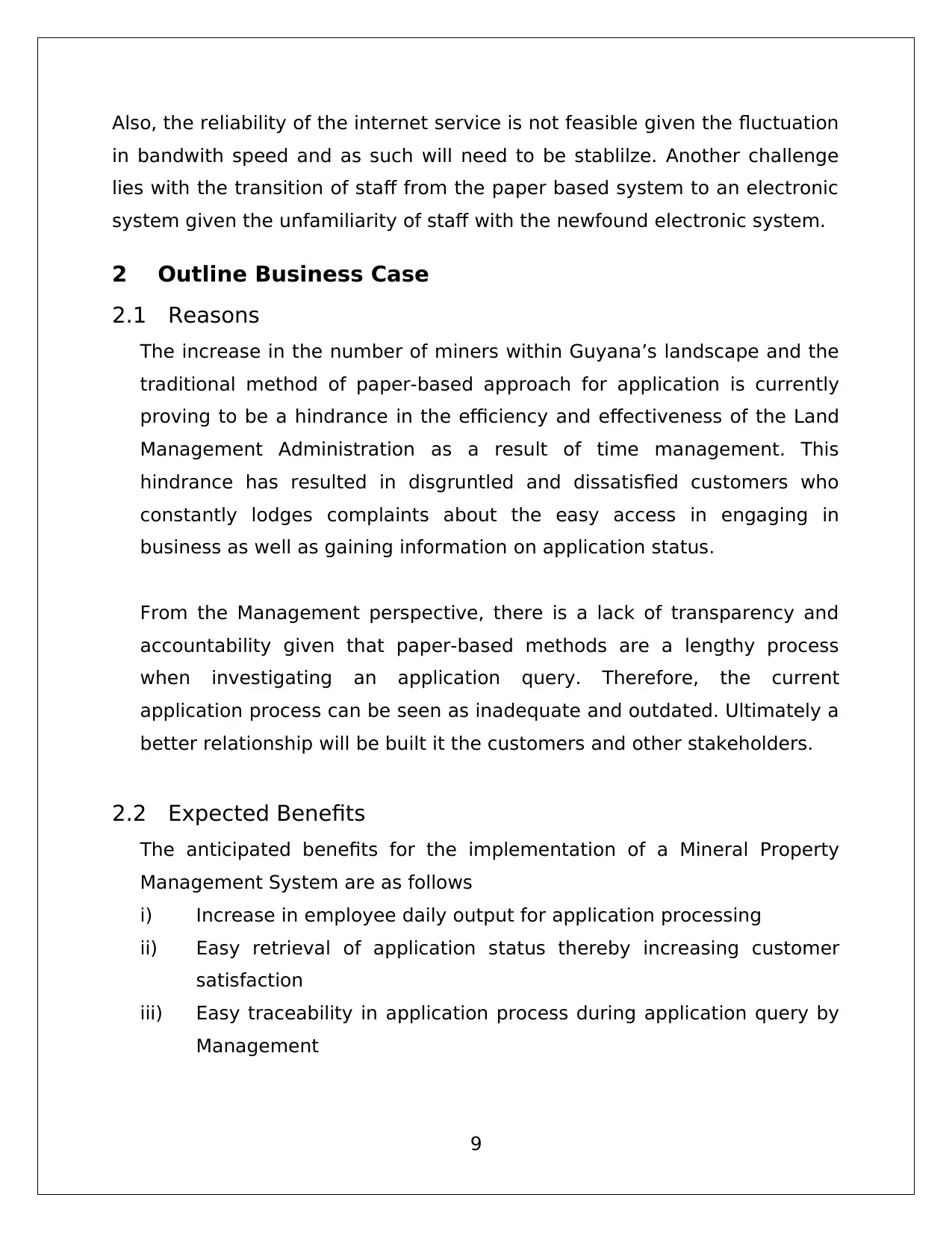
Also, the reliability of the internet service is not feasible given the fluctuation
in bandwith speed and as such will need to be stablilze. Another challenge
lies with the transition of staff from the paper based system to an electronic
system given the unfamiliarity of staff with the newfound electronic system.
2 Outline Business Case
2.1 Reasons
The increase in the number of miners within Guyana’s landscape and the
traditional method of paper-based approach for application is currently
proving to be a hindrance in the efficiency and effectiveness of the Land
Management Administration as a result of time management. This
hindrance has resulted in disgruntled and dissatisfied customers who
constantly lodges complaints about the easy access in engaging in
business as well as gaining information on application status.
From the Management perspective, there is a lack of transparency and
accountability given that paper-based methods are a lengthy process
when investigating an application query. Therefore, the current
application process can be seen as inadequate and outdated. Ultimately a
better relationship will be built it the customers and other stakeholders.
2.2 Expected Benefits
The anticipated benefits for the implementation of a Mineral Property
Management System are as follows
i) Increase in employee daily output for application processing
ii) Easy retrieval of application status thereby increasing customer
satisfaction
iii) Easy traceability in application process during application query by
Management
9
in bandwith speed and as such will need to be stablilze. Another challenge
lies with the transition of staff from the paper based system to an electronic
system given the unfamiliarity of staff with the newfound electronic system.
2 Outline Business Case
2.1 Reasons
The increase in the number of miners within Guyana’s landscape and the
traditional method of paper-based approach for application is currently
proving to be a hindrance in the efficiency and effectiveness of the Land
Management Administration as a result of time management. This
hindrance has resulted in disgruntled and dissatisfied customers who
constantly lodges complaints about the easy access in engaging in
business as well as gaining information on application status.
From the Management perspective, there is a lack of transparency and
accountability given that paper-based methods are a lengthy process
when investigating an application query. Therefore, the current
application process can be seen as inadequate and outdated. Ultimately a
better relationship will be built it the customers and other stakeholders.
2.2 Expected Benefits
The anticipated benefits for the implementation of a Mineral Property
Management System are as follows
i) Increase in employee daily output for application processing
ii) Easy retrieval of application status thereby increasing customer
satisfaction
iii) Easy traceability in application process during application query by
Management
9
Secure Best Marks with AI Grader
Need help grading? Try our AI Grader for instant feedback on your assignments.
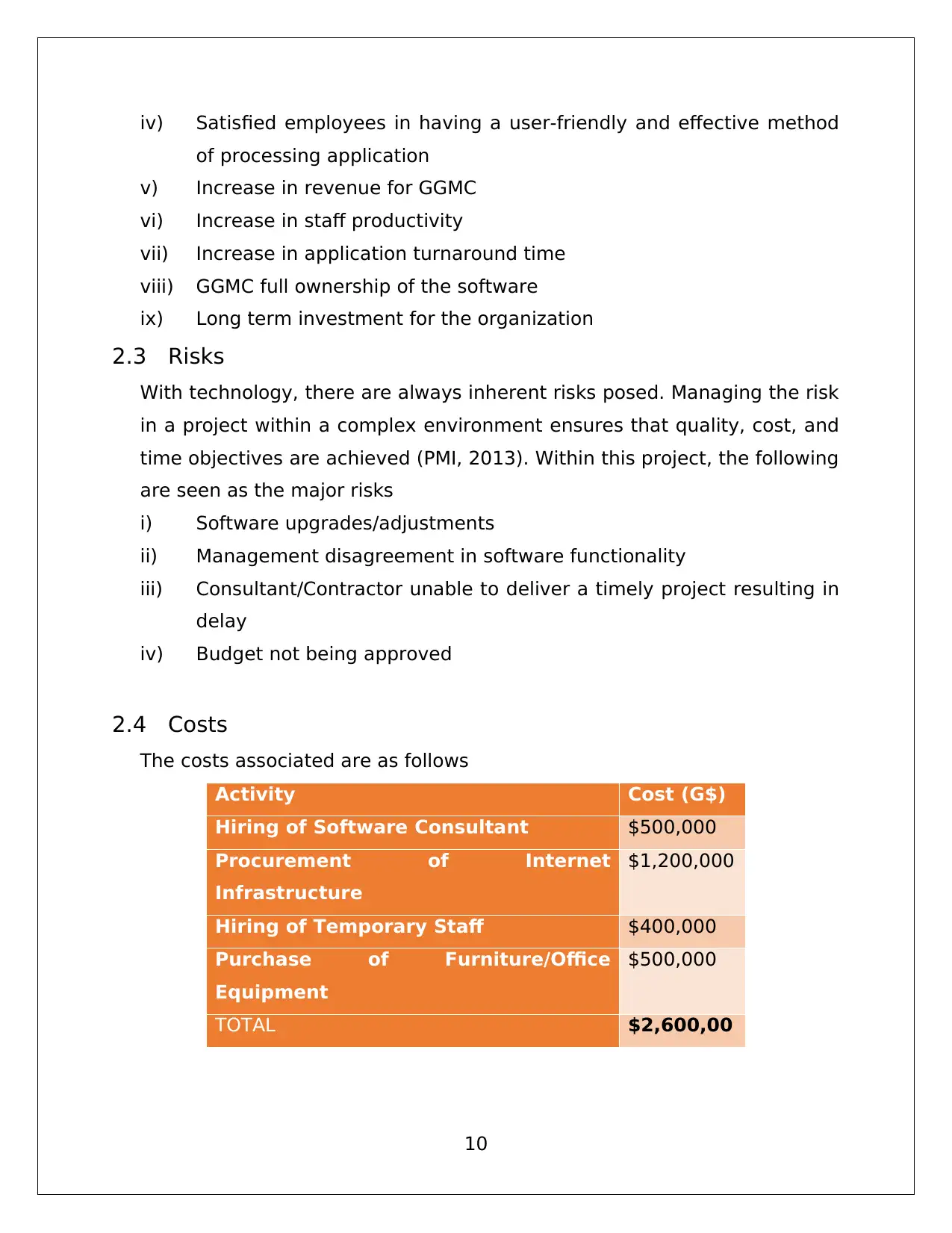
iv) Satisfied employees in having a user-friendly and effective method
of processing application
v) Increase in revenue for GGMC
vi) Increase in staff productivity
vii) Increase in application turnaround time
viii) GGMC full ownership of the software
ix) Long term investment for the organization
2.3 Risks
With technology, there are always inherent risks posed. Managing the risk
in a project within a complex environment ensures that quality, cost, and
time objectives are achieved (PMI, 2013). Within this project, the following
are seen as the major risks
i) Software upgrades/adjustments
ii) Management disagreement in software functionality
iii) Consultant/Contractor unable to deliver a timely project resulting in
delay
iv) Budget not being approved
2.4 Costs
The costs associated are as follows
Activity Cost (G$)
Hiring of Software Consultant $500,000
Procurement of Internet
Infrastructure
$1,200,000
Hiring of Temporary Staff $400,000
Purchase of Furniture/Office
Equipment
$500,000
TOTAL $2,600,00
10
of processing application
v) Increase in revenue for GGMC
vi) Increase in staff productivity
vii) Increase in application turnaround time
viii) GGMC full ownership of the software
ix) Long term investment for the organization
2.3 Risks
With technology, there are always inherent risks posed. Managing the risk
in a project within a complex environment ensures that quality, cost, and
time objectives are achieved (PMI, 2013). Within this project, the following
are seen as the major risks
i) Software upgrades/adjustments
ii) Management disagreement in software functionality
iii) Consultant/Contractor unable to deliver a timely project resulting in
delay
iv) Budget not being approved
2.4 Costs
The costs associated are as follows
Activity Cost (G$)
Hiring of Software Consultant $500,000
Procurement of Internet
Infrastructure
$1,200,000
Hiring of Temporary Staff $400,000
Purchase of Furniture/Office
Equipment
$500,000
TOTAL $2,600,00
10

2.5 Project Options
The necessity of this project cannot go unnoticed for its invaluable
contribution it would have not only on the employees in productivity but the
customer satisfaction in having their application process with speed. The
options are to change the current process so that the overall system can be
improved or to remain in the same position. However, the most feasible
option is to transform the current process to improve the overall operational
capability of the Land Administration Department. Also, the utilization of a
Joint Venture will be done with the Guyana Telephone and Telegraph
Company to enable mobile download of the MPMS app via PlayStore. Joint
Ventures are known for their resource-sharing advantages (Channon &
Sammut-Bonnici 2015) and GGMC will capitalize on this benefit.
11
The necessity of this project cannot go unnoticed for its invaluable
contribution it would have not only on the employees in productivity but the
customer satisfaction in having their application process with speed. The
options are to change the current process so that the overall system can be
improved or to remain in the same position. However, the most feasible
option is to transform the current process to improve the overall operational
capability of the Land Administration Department. Also, the utilization of a
Joint Venture will be done with the Guyana Telephone and Telegraph
Company to enable mobile download of the MPMS app via PlayStore. Joint
Ventures are known for their resource-sharing advantages (Channon &
Sammut-Bonnici 2015) and GGMC will capitalize on this benefit.
11
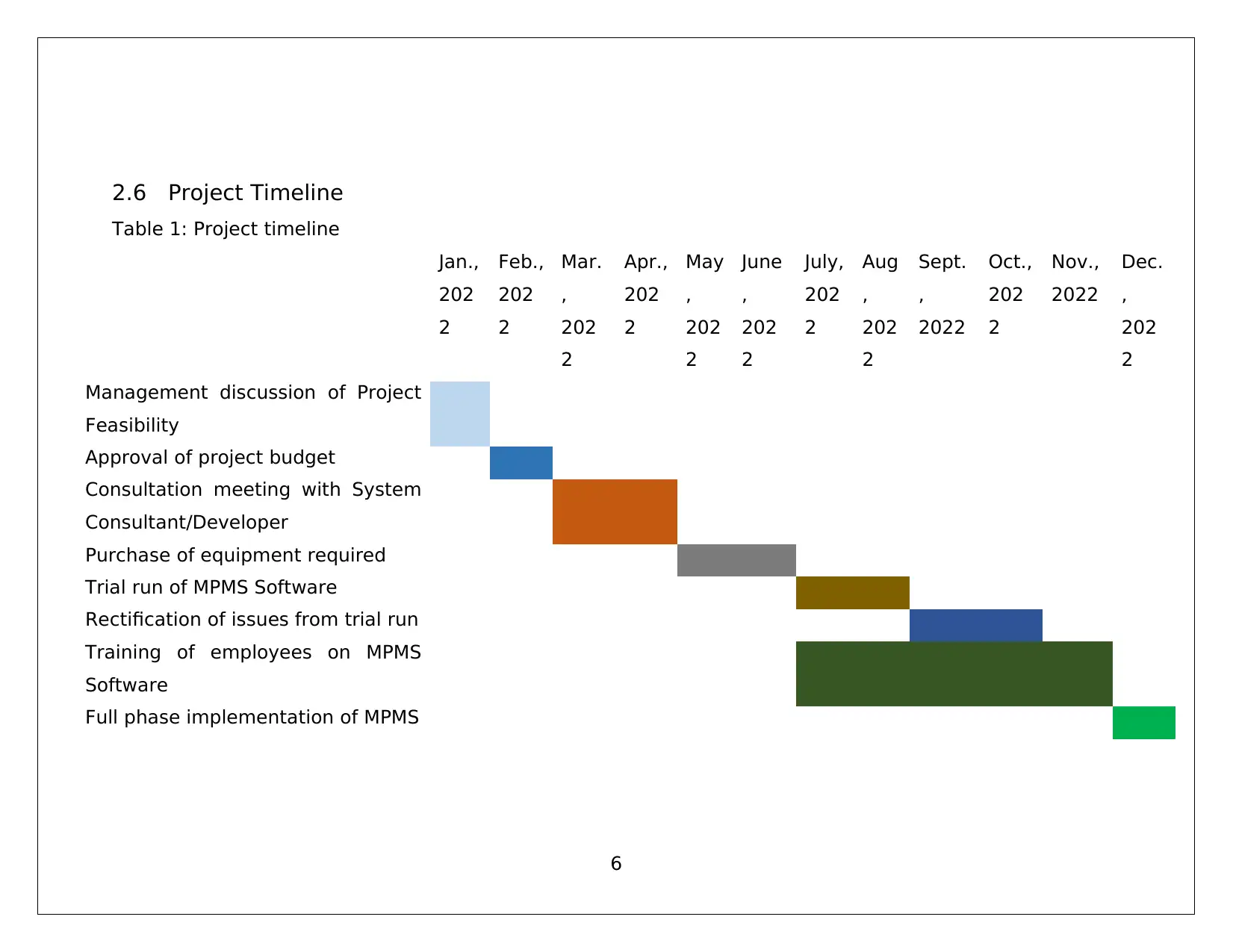
2.6 Project Timeline
Table 1: Project timeline
Jan.,
202
2
Feb.,
202
2
Mar.
,
202
2
Apr.,
202
2
May
,
202
2
June
,
202
2
July,
202
2
Aug
,
202
2
Sept.
,
2022
Oct.,
202
2
Nov.,
2022
Dec.
,
202
2
Management discussion of Project
Feasibility
Approval of project budget
Consultation meeting with System
Consultant/Developer
Purchase of equipment required
Trial run of MPMS Software
Rectification of issues from trial run
Training of employees on MPMS
Software
Full phase implementation of MPMS
6
Table 1: Project timeline
Jan.,
202
2
Feb.,
202
2
Mar.
,
202
2
Apr.,
202
2
May
,
202
2
June
,
202
2
July,
202
2
Aug
,
202
2
Sept.
,
2022
Oct.,
202
2
Nov.,
2022
Dec.
,
202
2
Management discussion of Project
Feasibility
Approval of project budget
Consultation meeting with System
Consultant/Developer
Purchase of equipment required
Trial run of MPMS Software
Rectification of issues from trial run
Training of employees on MPMS
Software
Full phase implementation of MPMS
6
Paraphrase This Document
Need a fresh take? Get an instant paraphrase of this document with our AI Paraphraser
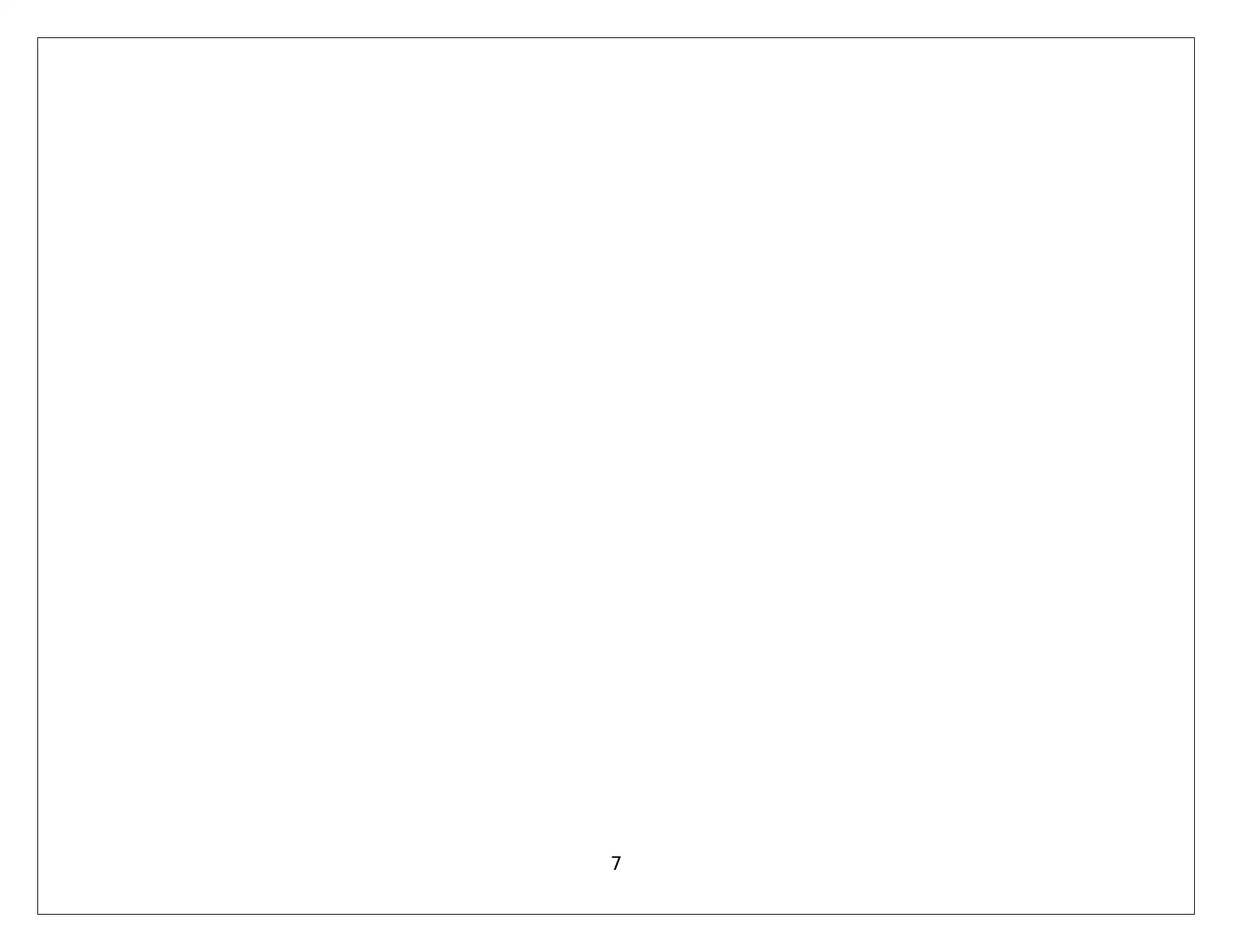
7
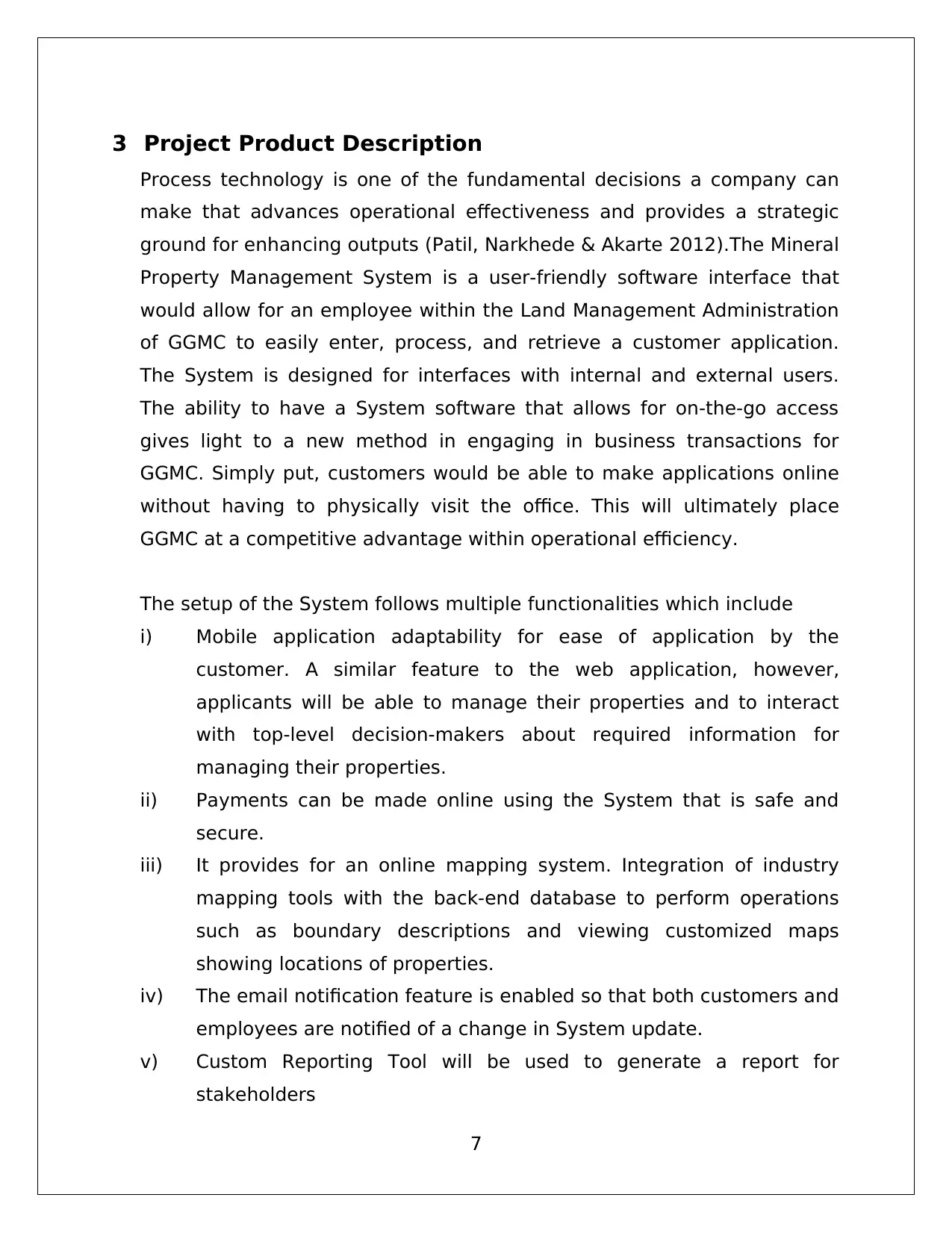
3 Project Product Description
Process technology is one of the fundamental decisions a company can
make that advances operational effectiveness and provides a strategic
ground for enhancing outputs (Patil, Narkhede & Akarte 2012).The Mineral
Property Management System is a user-friendly software interface that
would allow for an employee within the Land Management Administration
of GGMC to easily enter, process, and retrieve a customer application.
The System is designed for interfaces with internal and external users.
The ability to have a System software that allows for on-the-go access
gives light to a new method in engaging in business transactions for
GGMC. Simply put, customers would be able to make applications online
without having to physically visit the office. This will ultimately place
GGMC at a competitive advantage within operational efficiency.
The setup of the System follows multiple functionalities which include
i) Mobile application adaptability for ease of application by the
customer. A similar feature to the web application, however,
applicants will be able to manage their properties and to interact
with top-level decision-makers about required information for
managing their properties.
ii) Payments can be made online using the System that is safe and
secure.
iii) It provides for an online mapping system. Integration of industry
mapping tools with the back-end database to perform operations
such as boundary descriptions and viewing customized maps
showing locations of properties.
iv) The email notification feature is enabled so that both customers and
employees are notified of a change in System update.
v) Custom Reporting Tool will be used to generate a report for
stakeholders
7
Process technology is one of the fundamental decisions a company can
make that advances operational effectiveness and provides a strategic
ground for enhancing outputs (Patil, Narkhede & Akarte 2012).The Mineral
Property Management System is a user-friendly software interface that
would allow for an employee within the Land Management Administration
of GGMC to easily enter, process, and retrieve a customer application.
The System is designed for interfaces with internal and external users.
The ability to have a System software that allows for on-the-go access
gives light to a new method in engaging in business transactions for
GGMC. Simply put, customers would be able to make applications online
without having to physically visit the office. This will ultimately place
GGMC at a competitive advantage within operational efficiency.
The setup of the System follows multiple functionalities which include
i) Mobile application adaptability for ease of application by the
customer. A similar feature to the web application, however,
applicants will be able to manage their properties and to interact
with top-level decision-makers about required information for
managing their properties.
ii) Payments can be made online using the System that is safe and
secure.
iii) It provides for an online mapping system. Integration of industry
mapping tools with the back-end database to perform operations
such as boundary descriptions and viewing customized maps
showing locations of properties.
iv) The email notification feature is enabled so that both customers and
employees are notified of a change in System update.
v) Custom Reporting Tool will be used to generate a report for
stakeholders
7
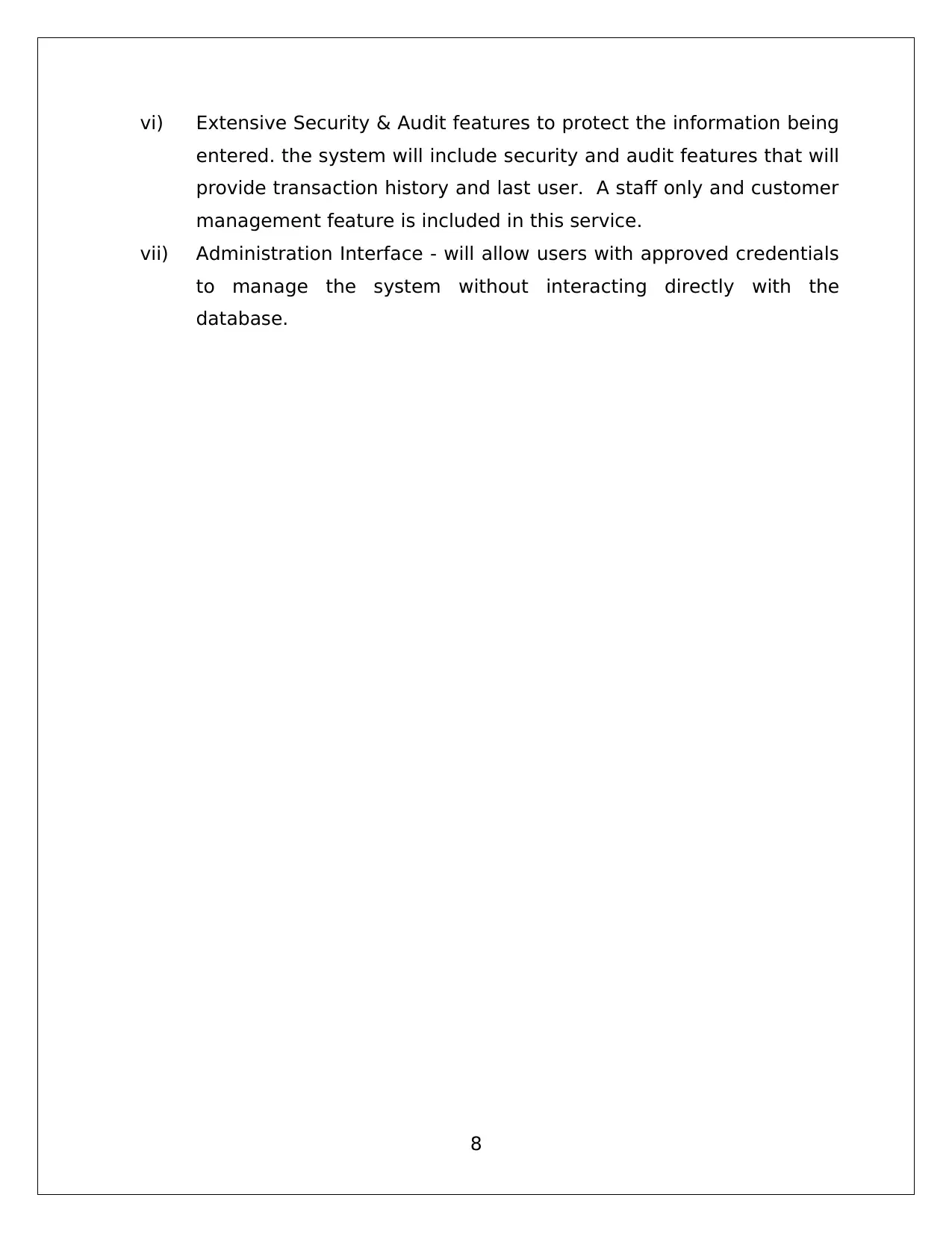
vi) Extensive Security & Audit features to protect the information being
entered. the system will include security and audit features that will
provide transaction history and last user. A staff only and customer
management feature is included in this service.
vii) Administration Interface - will allow users with approved credentials
to manage the system without interacting directly with the
database.
8
entered. the system will include security and audit features that will
provide transaction history and last user. A staff only and customer
management feature is included in this service.
vii) Administration Interface - will allow users with approved credentials
to manage the system without interacting directly with the
database.
8
Secure Best Marks with AI Grader
Need help grading? Try our AI Grader for instant feedback on your assignments.
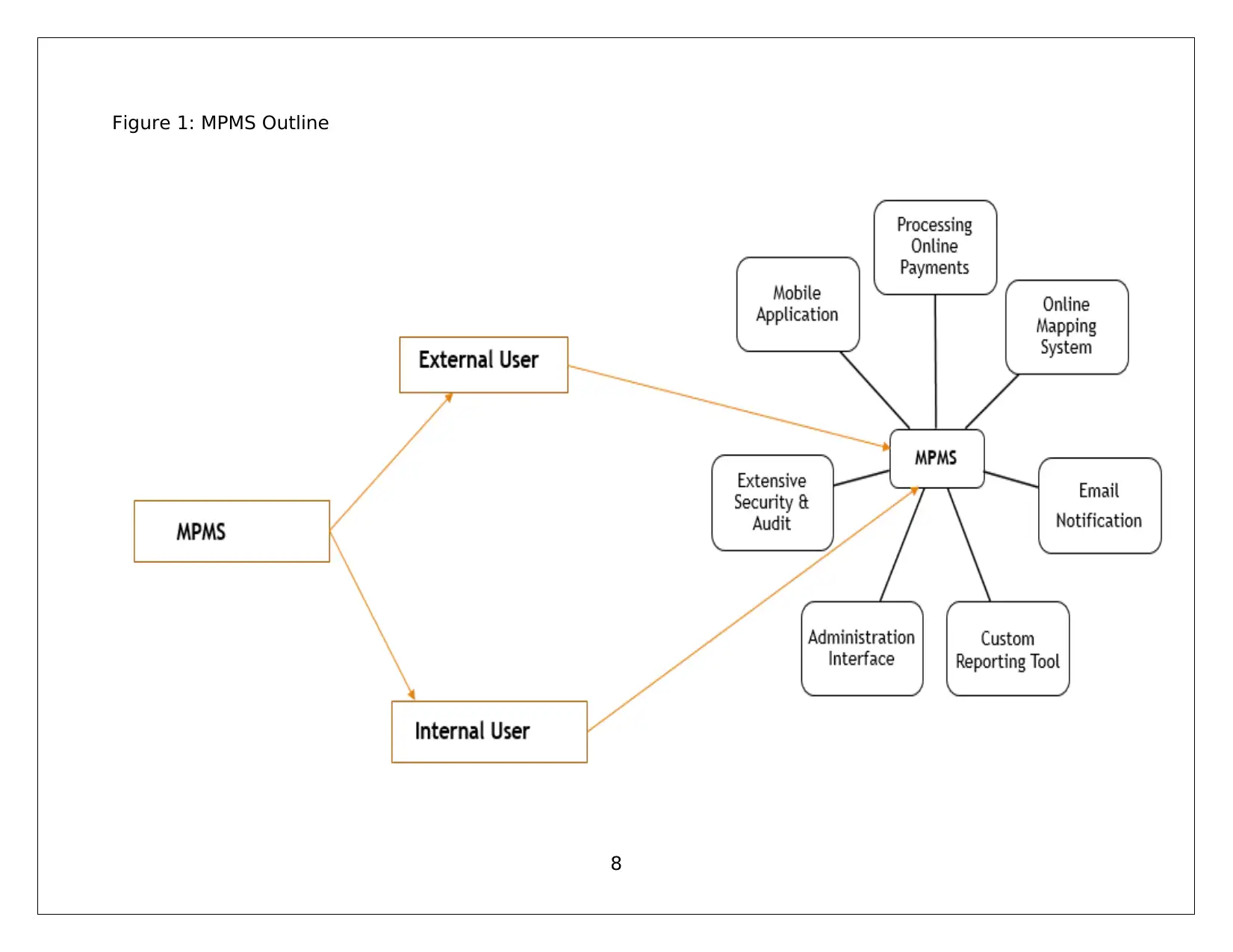
Figure 1: MPMS Outline
8
8
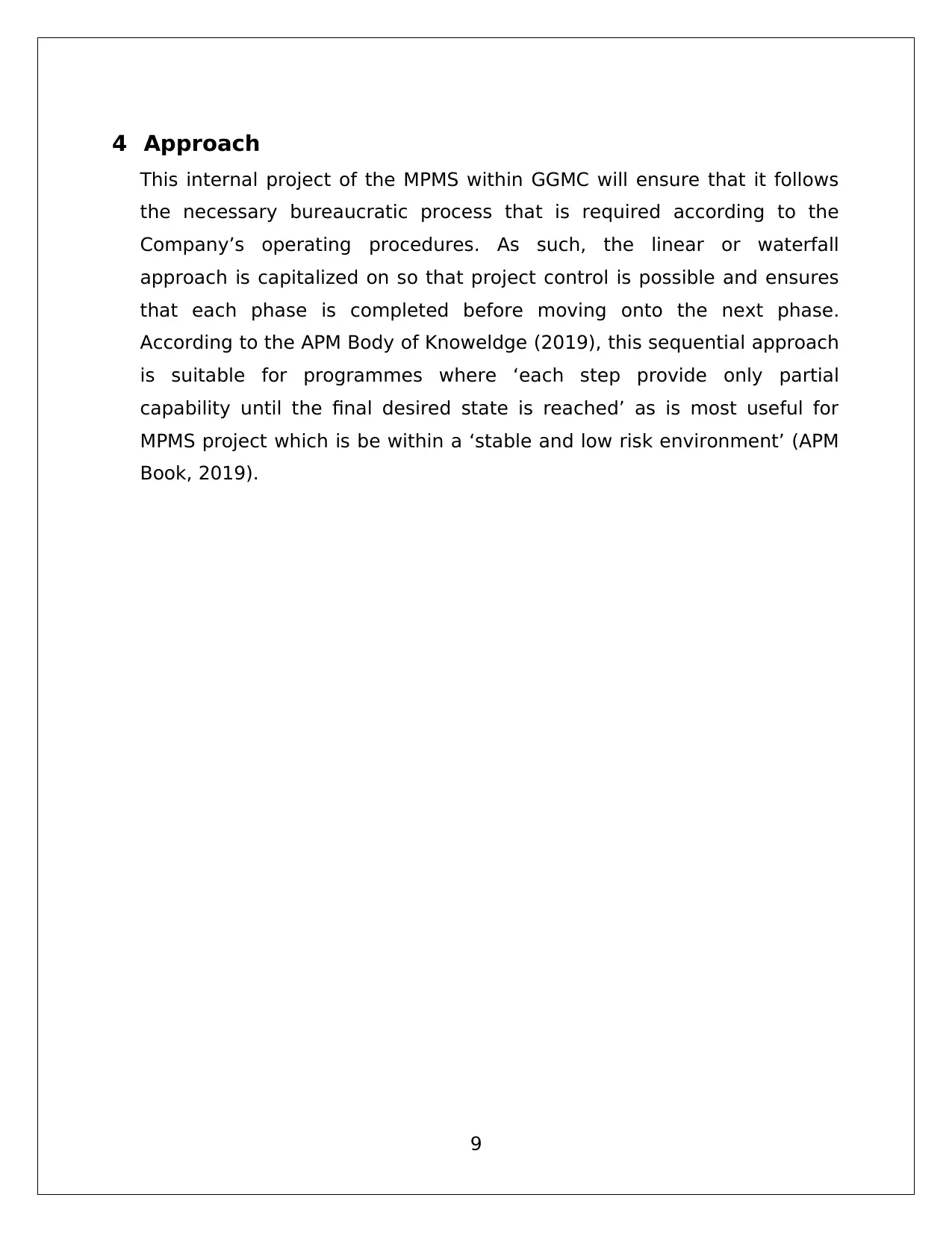
4 Approach
This internal project of the MPMS within GGMC will ensure that it follows
the necessary bureaucratic process that is required according to the
Company’s operating procedures. As such, the linear or waterfall
approach is capitalized on so that project control is possible and ensures
that each phase is completed before moving onto the next phase.
According to the APM Body of Knoweldge (2019), this sequential approach
is suitable for programmes where ‘each step provide only partial
capability until the final desired state is reached’ as is most useful for
MPMS project which is be within a ‘stable and low risk environment’ (APM
Book, 2019).
9
This internal project of the MPMS within GGMC will ensure that it follows
the necessary bureaucratic process that is required according to the
Company’s operating procedures. As such, the linear or waterfall
approach is capitalized on so that project control is possible and ensures
that each phase is completed before moving onto the next phase.
According to the APM Body of Knoweldge (2019), this sequential approach
is suitable for programmes where ‘each step provide only partial
capability until the final desired state is reached’ as is most useful for
MPMS project which is be within a ‘stable and low risk environment’ (APM
Book, 2019).
9
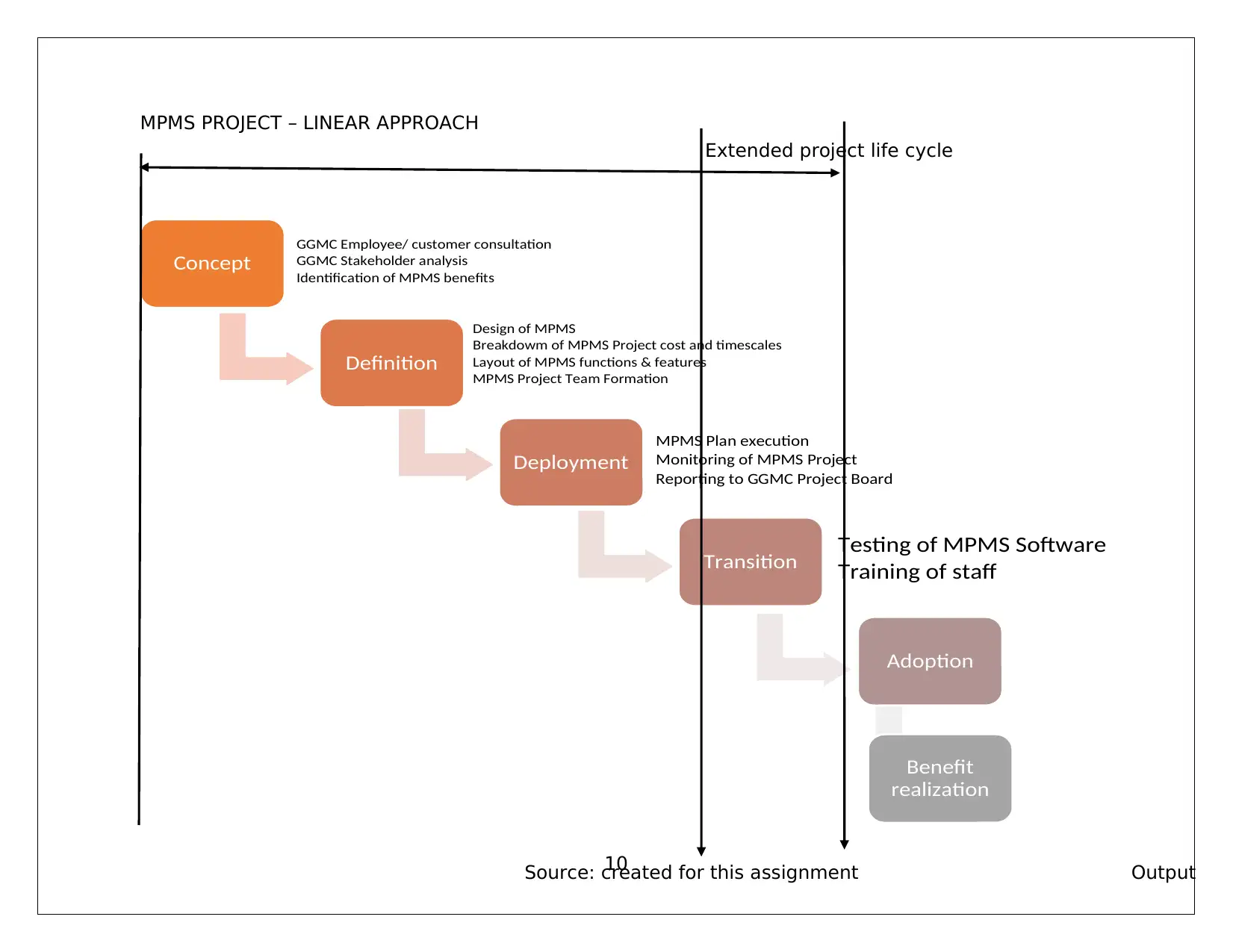
MPMS PROJECT – LINEAR APPROACH
10
Concept
GGMC Employee/ customer consultation
GGMC Stakeholder analysis
Identification of MPMS benefits
Definition
Design of MPMS
Breakdowm of MPMS Project cost and timescales
Layout of MPMS functions & features
MPMS Project Team Formation
Deployment
MPMS Plan execution
Monitoring of MPMS Project
Reporting to GGMC Project Board
Transition
Adoption
Benefit
realization
Testing of MPMS Software
Training of staff
Extended project life cycle
OutputSource: created for this assignment
10
Concept
GGMC Employee/ customer consultation
GGMC Stakeholder analysis
Identification of MPMS benefits
Definition
Design of MPMS
Breakdowm of MPMS Project cost and timescales
Layout of MPMS functions & features
MPMS Project Team Formation
Deployment
MPMS Plan execution
Monitoring of MPMS Project
Reporting to GGMC Project Board
Transition
Adoption
Benefit
realization
Testing of MPMS Software
Training of staff
Extended project life cycle
OutputSource: created for this assignment
Paraphrase This Document
Need a fresh take? Get an instant paraphrase of this document with our AI Paraphraser
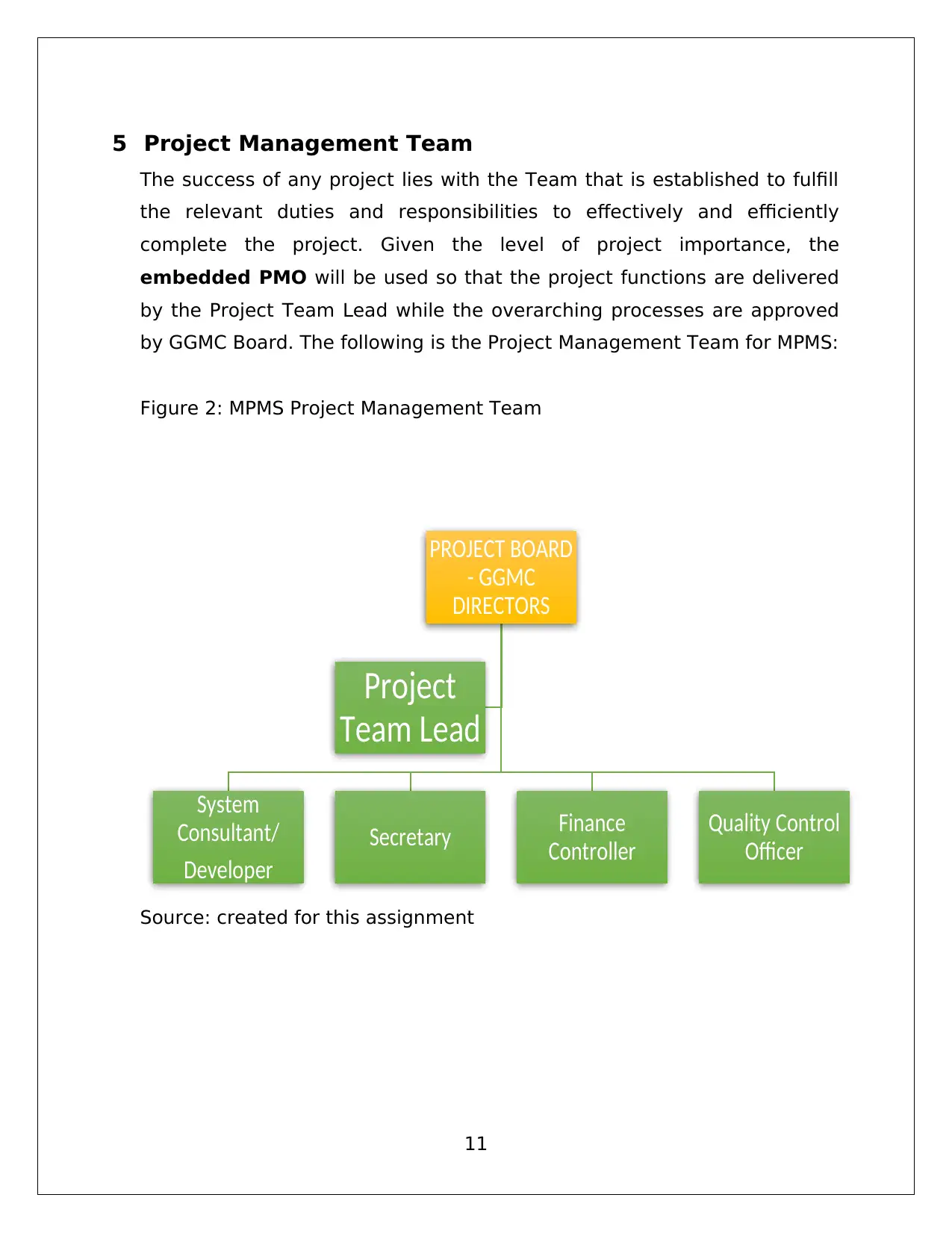
5 Project Management Team
The success of any project lies with the Team that is established to fulfill
the relevant duties and responsibilities to effectively and efficiently
complete the project. Given the level of project importance, the
embedded PMO will be used so that the project functions are delivered
by the Project Team Lead while the overarching processes are approved
by GGMC Board. The following is the Project Management Team for MPMS:
Figure 2: MPMS Project Management Team
Source: created for this assignment
11
PROJECT BOARD
- GGMC
DIRECTORS
System
Consultant/
Developer
Secretary Finance
Controller
Quality Control
Officer
Project
Team Lead
The success of any project lies with the Team that is established to fulfill
the relevant duties and responsibilities to effectively and efficiently
complete the project. Given the level of project importance, the
embedded PMO will be used so that the project functions are delivered
by the Project Team Lead while the overarching processes are approved
by GGMC Board. The following is the Project Management Team for MPMS:
Figure 2: MPMS Project Management Team
Source: created for this assignment
11
PROJECT BOARD
- GGMC
DIRECTORS
System
Consultant/
Developer
Secretary Finance
Controller
Quality Control
Officer
Project
Team Lead
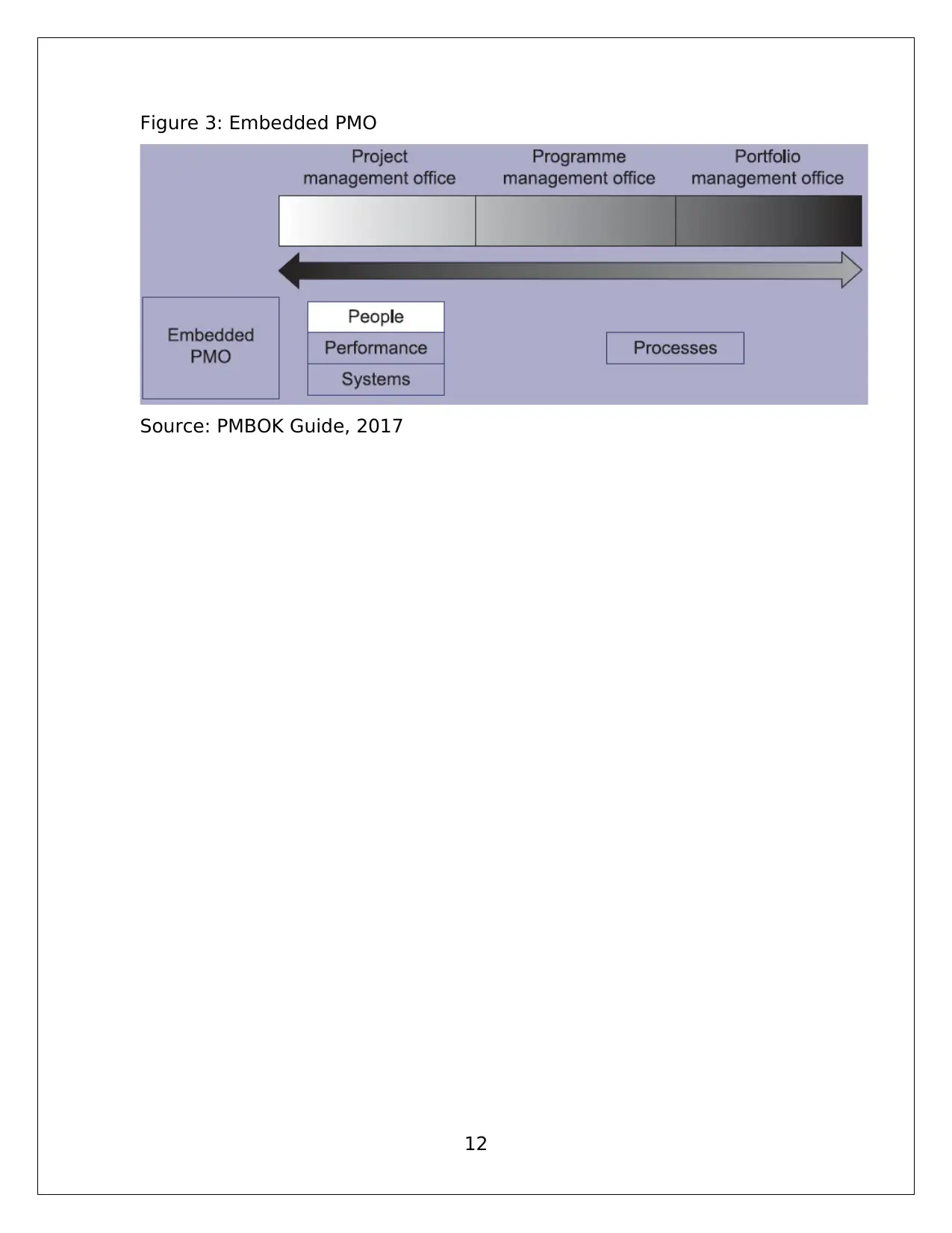
Figure 3: Embedded PMO
Source: PMBOK Guide, 2017
12
Source: PMBOK Guide, 2017
12
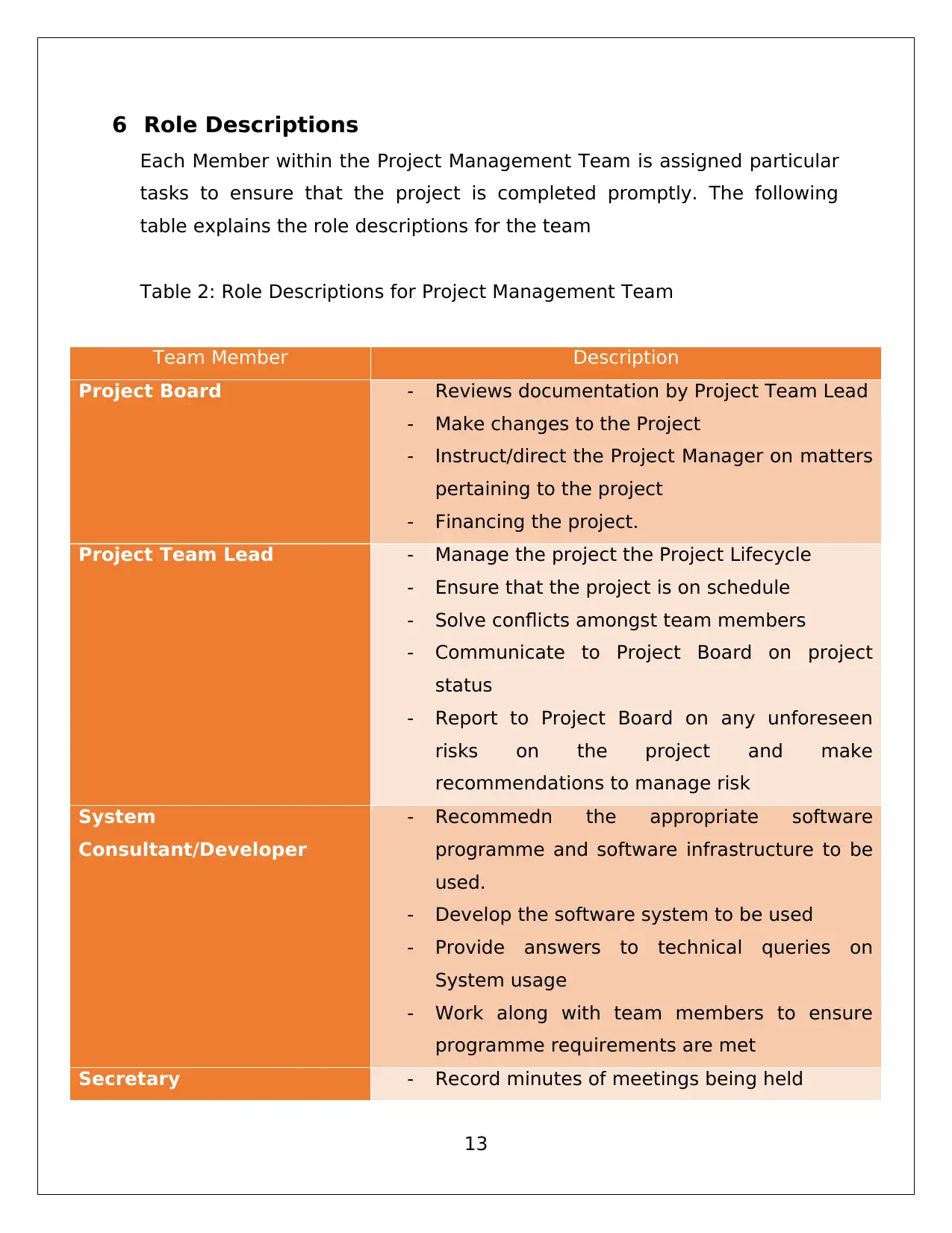
6 Role Descriptions
Each Member within the Project Management Team is assigned particular
tasks to ensure that the project is completed promptly. The following
table explains the role descriptions for the team
Table 2: Role Descriptions for Project Management Team
Team Member Description
Project Board - Reviews documentation by Project Team Lead
- Make changes to the Project
- Instruct/direct the Project Manager on matters
pertaining to the project
- Financing the project.
Project Team Lead - Manage the project the Project Lifecycle
- Ensure that the project is on schedule
- Solve conflicts amongst team members
- Communicate to Project Board on project
status
- Report to Project Board on any unforeseen
risks on the project and make
recommendations to manage risk
System
Consultant/Developer
- Recommedn the appropriate software
programme and software infrastructure to be
used.
- Develop the software system to be used
- Provide answers to technical queries on
System usage
- Work along with team members to ensure
programme requirements are met
Secretary - Record minutes of meetings being held
13
Each Member within the Project Management Team is assigned particular
tasks to ensure that the project is completed promptly. The following
table explains the role descriptions for the team
Table 2: Role Descriptions for Project Management Team
Team Member Description
Project Board - Reviews documentation by Project Team Lead
- Make changes to the Project
- Instruct/direct the Project Manager on matters
pertaining to the project
- Financing the project.
Project Team Lead - Manage the project the Project Lifecycle
- Ensure that the project is on schedule
- Solve conflicts amongst team members
- Communicate to Project Board on project
status
- Report to Project Board on any unforeseen
risks on the project and make
recommendations to manage risk
System
Consultant/Developer
- Recommedn the appropriate software
programme and software infrastructure to be
used.
- Develop the software system to be used
- Provide answers to technical queries on
System usage
- Work along with team members to ensure
programme requirements are met
Secretary - Record minutes of meetings being held
13
Secure Best Marks with AI Grader
Need help grading? Try our AI Grader for instant feedback on your assignments.
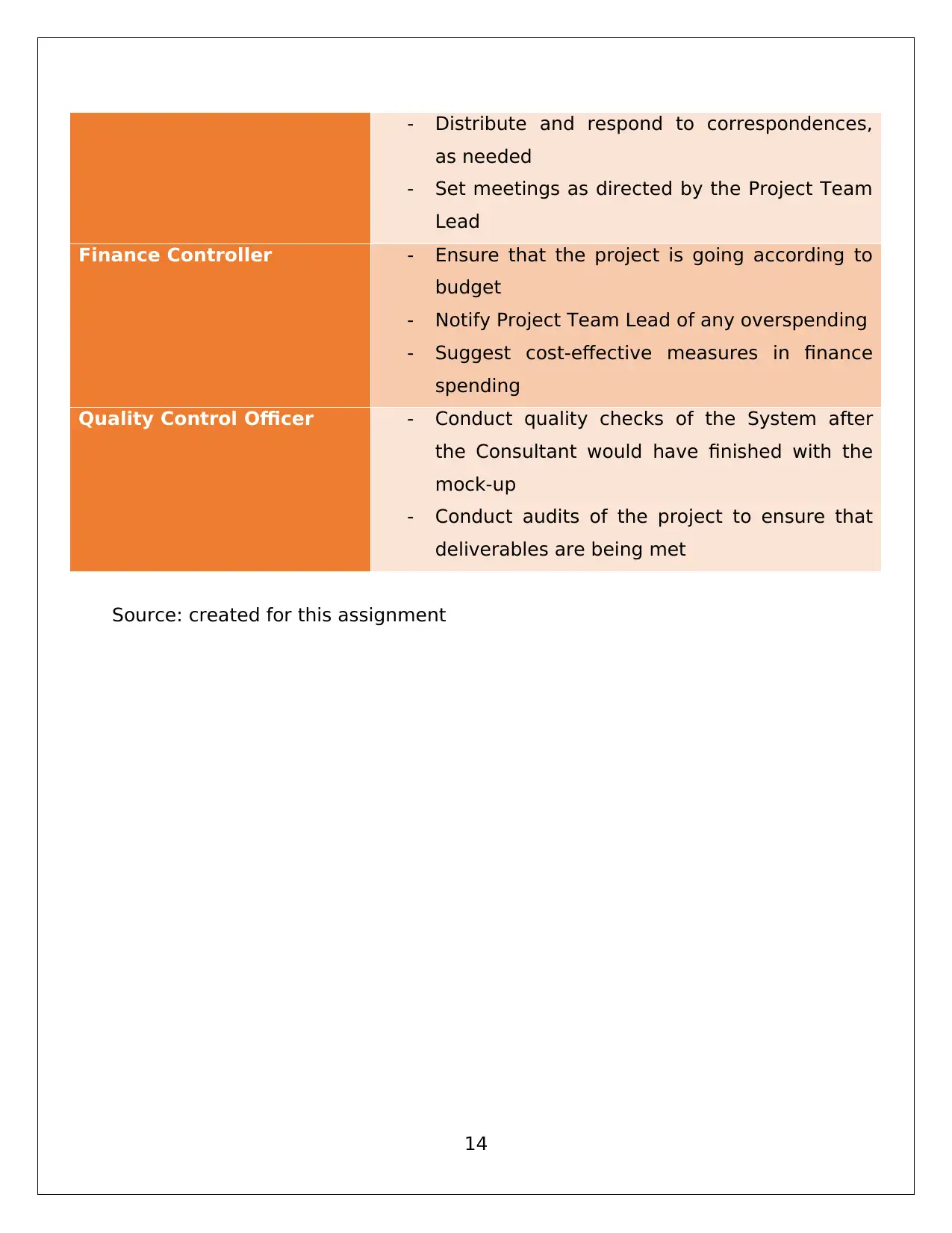
- Distribute and respond to correspondences,
as needed
- Set meetings as directed by the Project Team
Lead
Finance Controller - Ensure that the project is going according to
budget
- Notify Project Team Lead of any overspending
- Suggest cost-effective measures in finance
spending
Quality Control Officer - Conduct quality checks of the System after
the Consultant would have finished with the
mock-up
- Conduct audits of the project to ensure that
deliverables are being met
Source: created for this assignment
14
as needed
- Set meetings as directed by the Project Team
Lead
Finance Controller - Ensure that the project is going according to
budget
- Notify Project Team Lead of any overspending
- Suggest cost-effective measures in finance
spending
Quality Control Officer - Conduct quality checks of the System after
the Consultant would have finished with the
mock-up
- Conduct audits of the project to ensure that
deliverables are being met
Source: created for this assignment
14
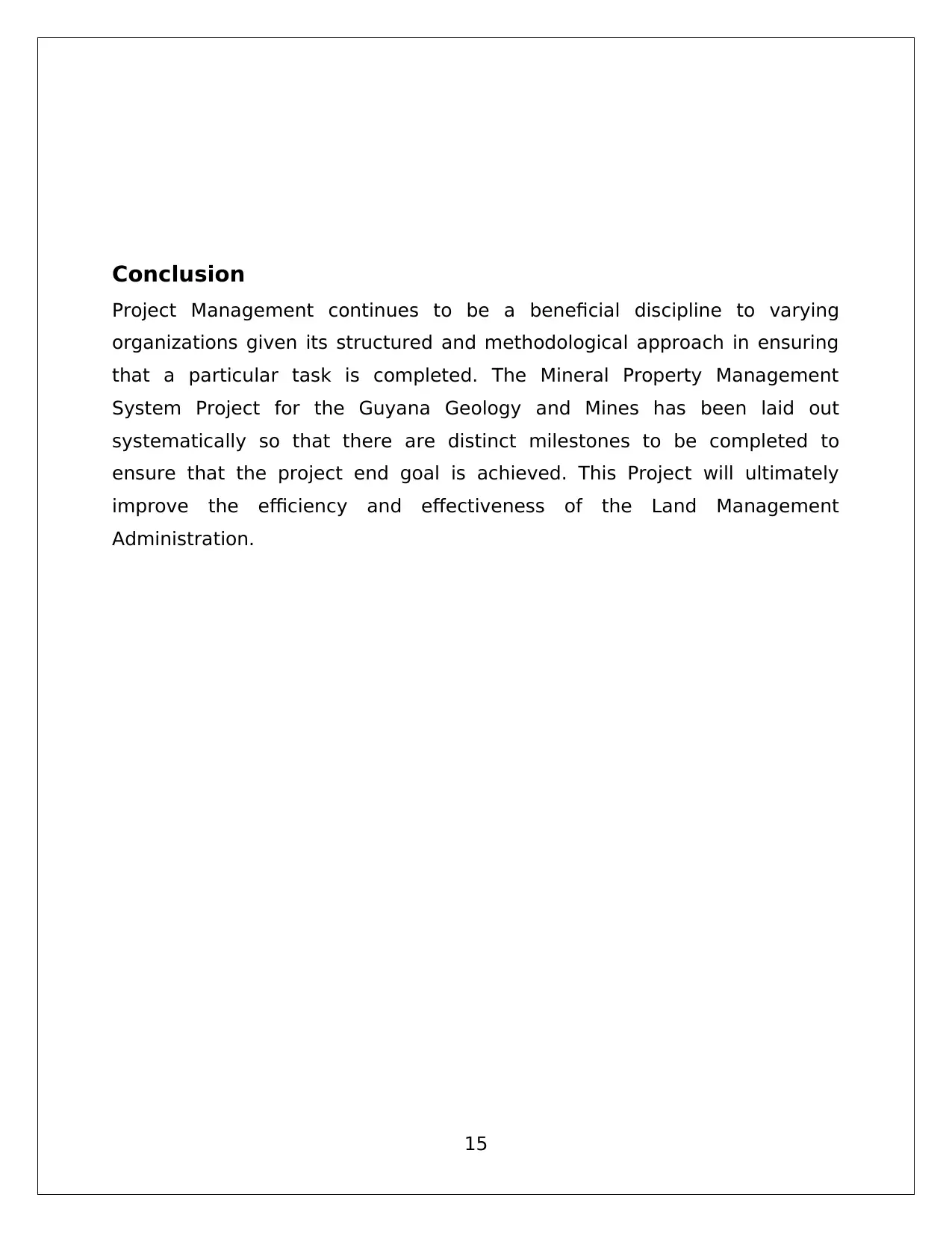
Conclusion
Project Management continues to be a beneficial discipline to varying
organizations given its structured and methodological approach in ensuring
that a particular task is completed. The Mineral Property Management
System Project for the Guyana Geology and Mines has been laid out
systematically so that there are distinct milestones to be completed to
ensure that the project end goal is achieved. This Project will ultimately
improve the efficiency and effectiveness of the Land Management
Administration.
15
Project Management continues to be a beneficial discipline to varying
organizations given its structured and methodological approach in ensuring
that a particular task is completed. The Mineral Property Management
System Project for the Guyana Geology and Mines has been laid out
systematically so that there are distinct milestones to be completed to
ensure that the project end goal is achieved. This Project will ultimately
improve the efficiency and effectiveness of the Land Management
Administration.
15
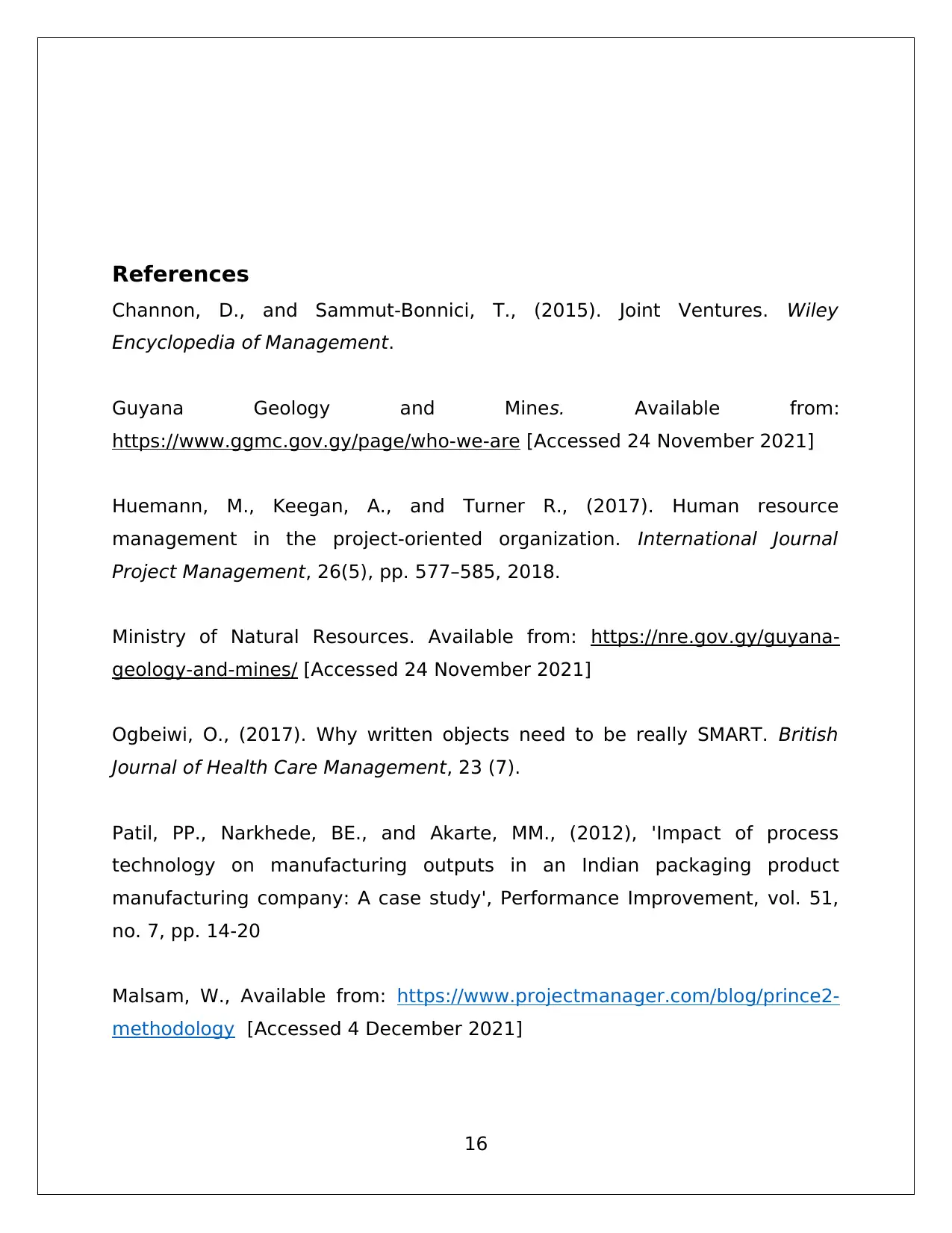
References
Channon, D., and Sammut-Bonnici, T., (2015). Joint Ventures. Wiley
Encyclopedia of Management.
Guyana Geology and Mines. Available from:
https://www.ggmc.gov.gy/page/who-we-are [Accessed 24 November 2021]
Huemann, M., Keegan, A., and Turner R., (2017). Human resource
management in the project-oriented organization. International Journal
Project Management, 26(5), pp. 577–585, 2018.
Ministry of Natural Resources. Available from: https://nre.gov.gy/guyana-
geology-and-mines/ [Accessed 24 November 2021]
Ogbeiwi, O., (2017). Why written objects need to be really SMART. British
Journal of Health Care Management, 23 (7).
Patil, PP., Narkhede, BE., and Akarte, MM., (2012), 'Impact of process
technology on manufacturing outputs in an Indian packaging product
manufacturing company: A case study', Performance Improvement, vol. 51,
no. 7, pp. 14-20
Malsam, W., Available from: https://www.projectmanager.com/blog/prince2-
methodology [Accessed 4 December 2021]
16
Channon, D., and Sammut-Bonnici, T., (2015). Joint Ventures. Wiley
Encyclopedia of Management.
Guyana Geology and Mines. Available from:
https://www.ggmc.gov.gy/page/who-we-are [Accessed 24 November 2021]
Huemann, M., Keegan, A., and Turner R., (2017). Human resource
management in the project-oriented organization. International Journal
Project Management, 26(5), pp. 577–585, 2018.
Ministry of Natural Resources. Available from: https://nre.gov.gy/guyana-
geology-and-mines/ [Accessed 24 November 2021]
Ogbeiwi, O., (2017). Why written objects need to be really SMART. British
Journal of Health Care Management, 23 (7).
Patil, PP., Narkhede, BE., and Akarte, MM., (2012), 'Impact of process
technology on manufacturing outputs in an Indian packaging product
manufacturing company: A case study', Performance Improvement, vol. 51,
no. 7, pp. 14-20
Malsam, W., Available from: https://www.projectmanager.com/blog/prince2-
methodology [Accessed 4 December 2021]
16
Paraphrase This Document
Need a fresh take? Get an instant paraphrase of this document with our AI Paraphraser
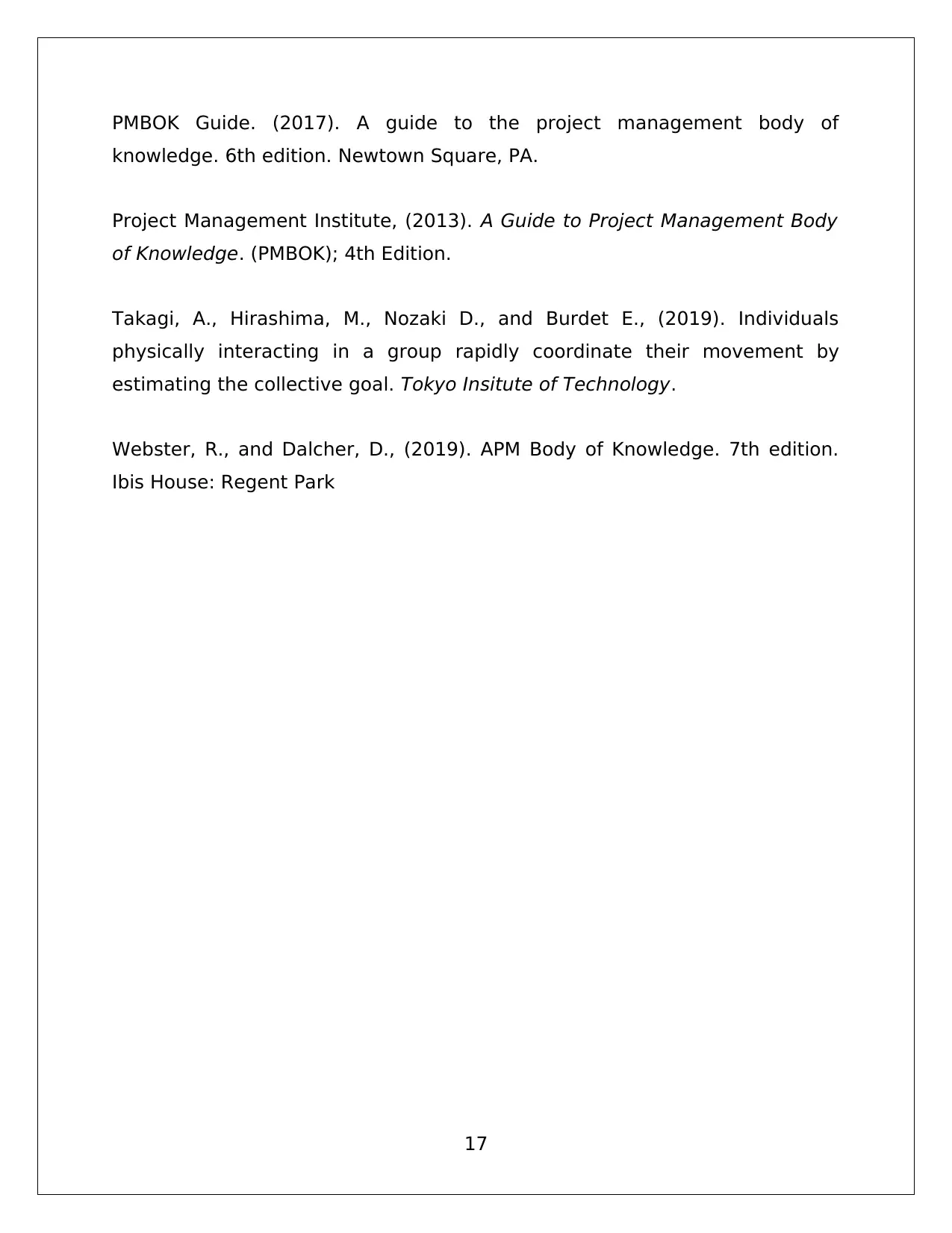
PMBOK Guide. (2017). A guide to the project management body of
knowledge. 6th edition. Newtown Square, PA.
Project Management Institute, (2013). A Guide to Project Management Body
of Knowledge. (PMBOK); 4th Edition.
Takagi, A., Hirashima, M., Nozaki D., and Burdet E., (2019). Individuals
physically interacting in a group rapidly coordinate their movement by
estimating the collective goal. Tokyo Insitute of Technology.
Webster, R., and Dalcher, D., (2019). APM Body of Knowledge. 7th edition.
Ibis House: Regent Park
17
knowledge. 6th edition. Newtown Square, PA.
Project Management Institute, (2013). A Guide to Project Management Body
of Knowledge. (PMBOK); 4th Edition.
Takagi, A., Hirashima, M., Nozaki D., and Burdet E., (2019). Individuals
physically interacting in a group rapidly coordinate their movement by
estimating the collective goal. Tokyo Insitute of Technology.
Webster, R., and Dalcher, D., (2019). APM Body of Knowledge. 7th edition.
Ibis House: Regent Park
17
1 out of 26
Related Documents
Your All-in-One AI-Powered Toolkit for Academic Success.
+13062052269
info@desklib.com
Available 24*7 on WhatsApp / Email
![[object Object]](/_next/static/media/star-bottom.7253800d.svg)
Unlock your academic potential
© 2024 | Zucol Services PVT LTD | All rights reserved.





